We visited Osaka (pronounced O-saka rather than o-SAR-ka) on our very first trip to Japan many years ago. We had already spent time exploring Tokyo, Hakone and Kamakura and it was following an afternoon and evening in Osaka, exploring the neon arcades and playing video games, taking silly photos in the print club booths, riding the Hep 5 big wheel and singing our socks off in a karaoke bar (where you get a private booth rather than have to sing in front of complete strangers), that we realised that we had fallen in love with Japan. The following day we visited the Dotonbori area in the Namba district and discovered Osaka’s restaurants. We decided that Osaka was our favourite place in the world.
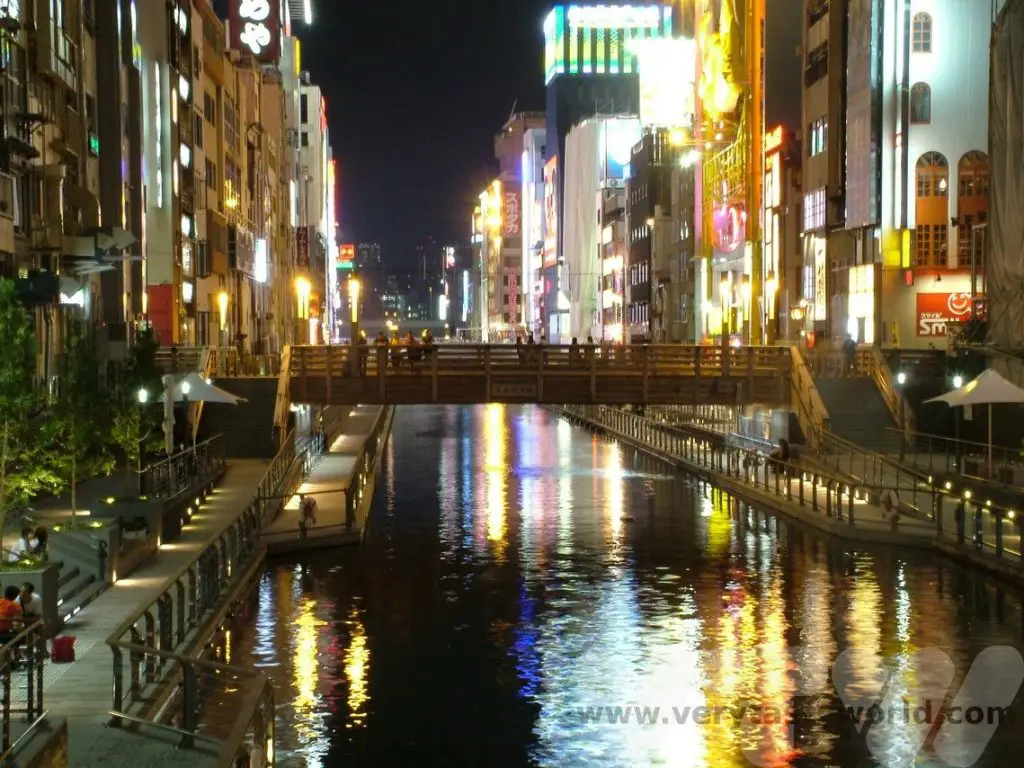
We’ve returned to Osaka many times over the years and we always make a beeline for Dotonbori. We’ve often stayed in business hotels close by. It’s a short walk away from the JR Namba Station Exit 14 (Yamatoji line), which is especially useful if you are using your JR Pass. Be aware that Namba is a big station. If you are arriving on the shinkansen (bullet train) you can get there from Shin-Osaka using the subway Midosuji line to Shinsaibashi Exit 4-B. (N.B. you can’t use your JR Pass on the subway.)

Osaka is known for being one of Japan’s centres of commerce, indeed there’s a phrase that many salarymen use as a greeting: ‘mokari makka’ which means ‘are you making money?’ The residents of Osaka speak Kansai Ben, the dialect of the region. It’s quite different to the Japanese we’ve learned in classes. For example, Osaka residents will say, ‘okini’ as thanks instead of ‘arigato’; although arigato will absolutely be understood you may well receive a big smile if you use ‘okini.’
Dotonbori History
Dotonbori means ‘Doton Canal’ and the history of the area goes back several hundred years to 1612 when Yasui Doton, a local merchant, started constructing a canal system in the area to link the Kizugawa river to the Umezu river. However, he was killed in 1615 during the Siege of Osaka and his cousins completed the canal project, naming it after Doton. Following completion, the area thrived, trade increased due to the better transportation along the canal and Dotonburi became an entertainment district, with theatres, teahouses and restaurants. It’s a fantastic place to visit, especially for foodies!
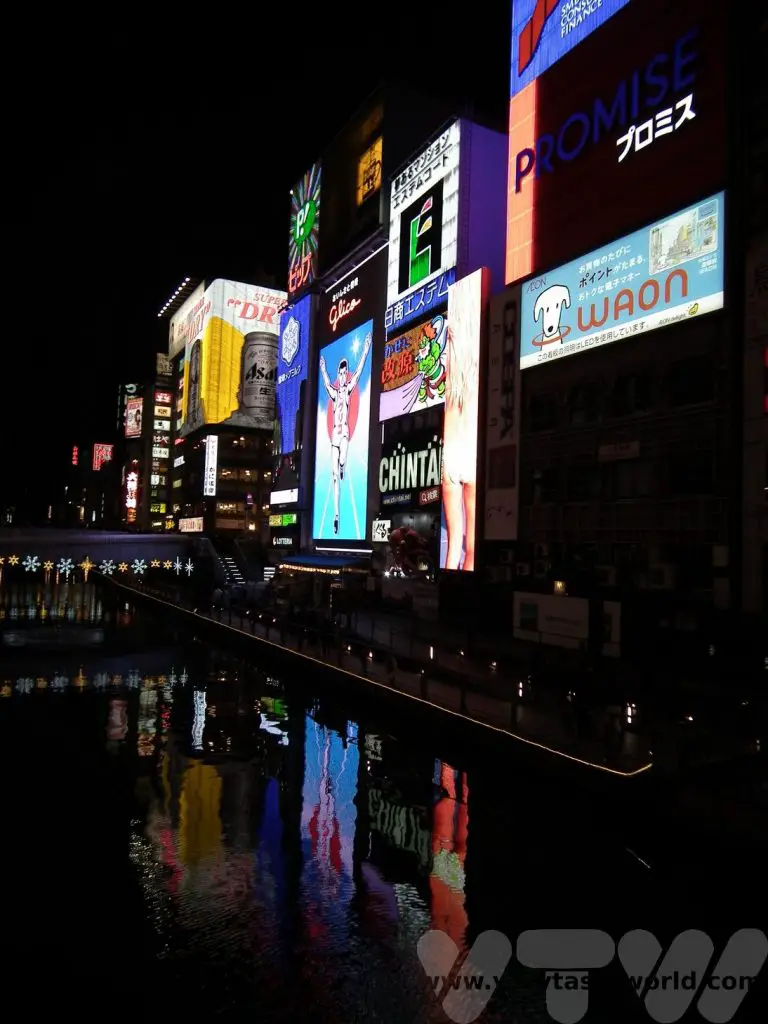
The district is defined by street between the Dotonboribashi Bridge to Nipponbashi Bridge. Probably the most iconic image of the area is that of the Glico running man – and it’s essential to see him at night, brightly lit in neon. Glico is a sweet manufacturer established in 1922 and famous across Japan. They are probably best know for those delicious Pocky coated biscuit sticks.
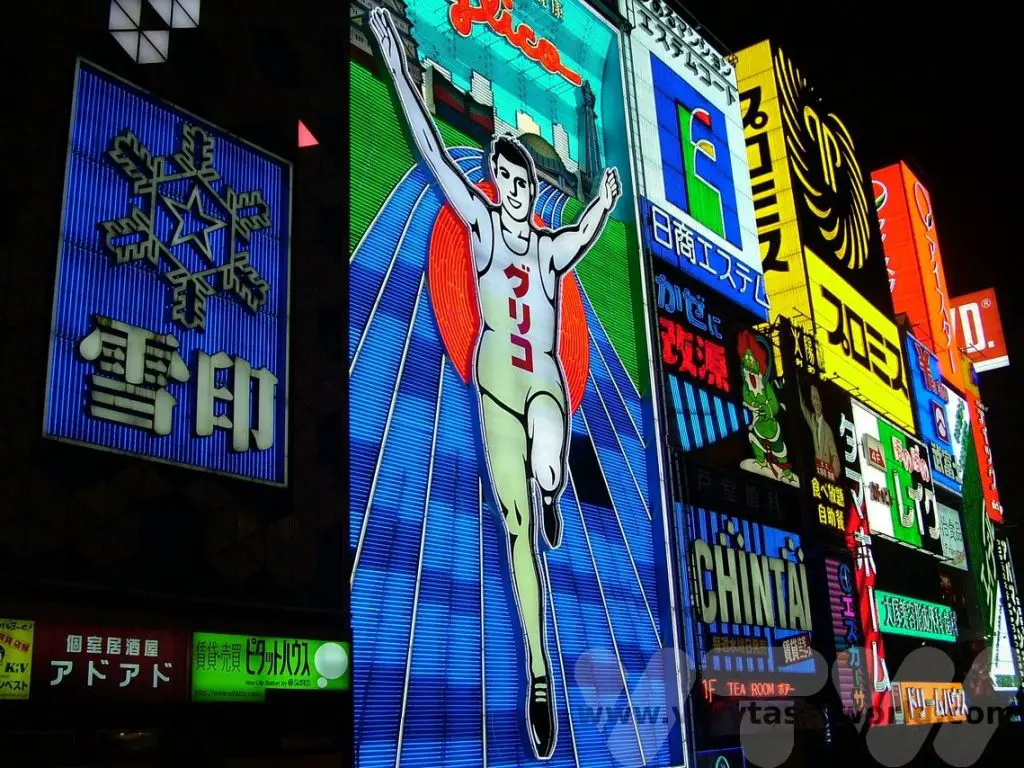
Dotonbori is one street, but actually the surrounding streets are also full of excellent bars and restaurants. We’ve had some of our best nights out in Osaka by wandering into random bars in the area. Locals and tourists alike are very friendly and we’ve often just started chatting with people. There was one particularly memorable night when a pair of airline pilots decided to buy Jagermeister bombs (a Jagermeister shot inside a glass of Red Bull) for the denizens of the entire bar which resulted in a highly caffeinated boozy evening and us sleeping in so late that we missed much of a planned excursion to Kobe the following day!
Kuidaore
The word ‘kuidaore’ means to go bankrupt by extravagant spending on food and Dotonbori would be a place where you could have a really good attempt at achieving this as it is chock full of excellent restaurants.
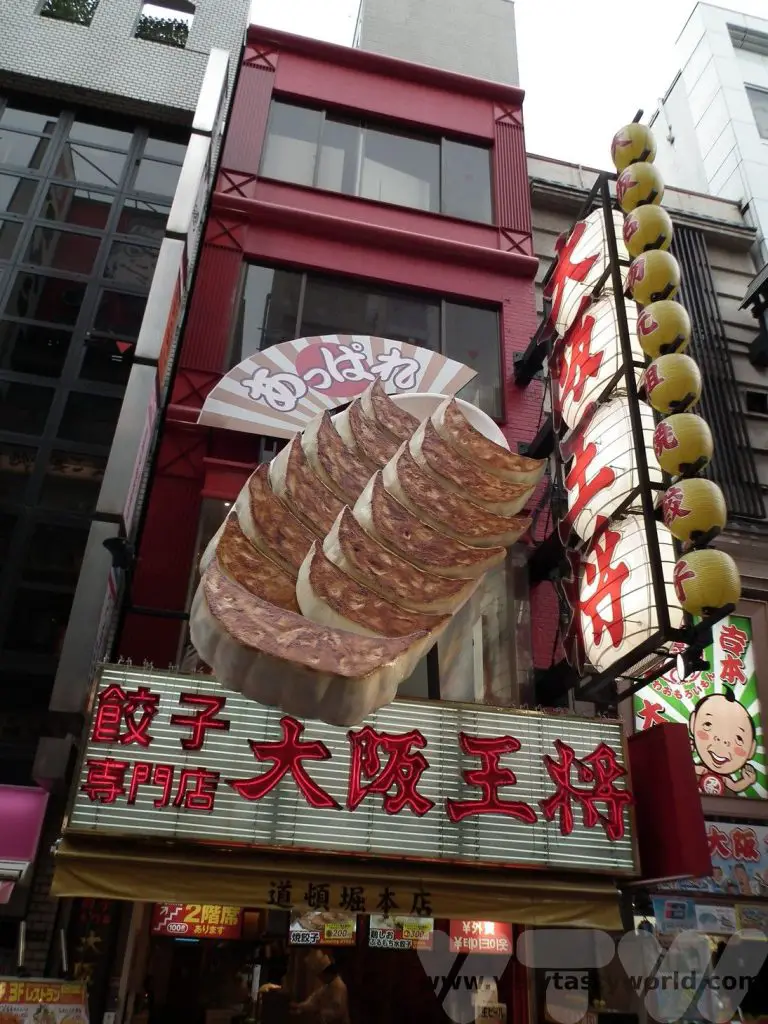
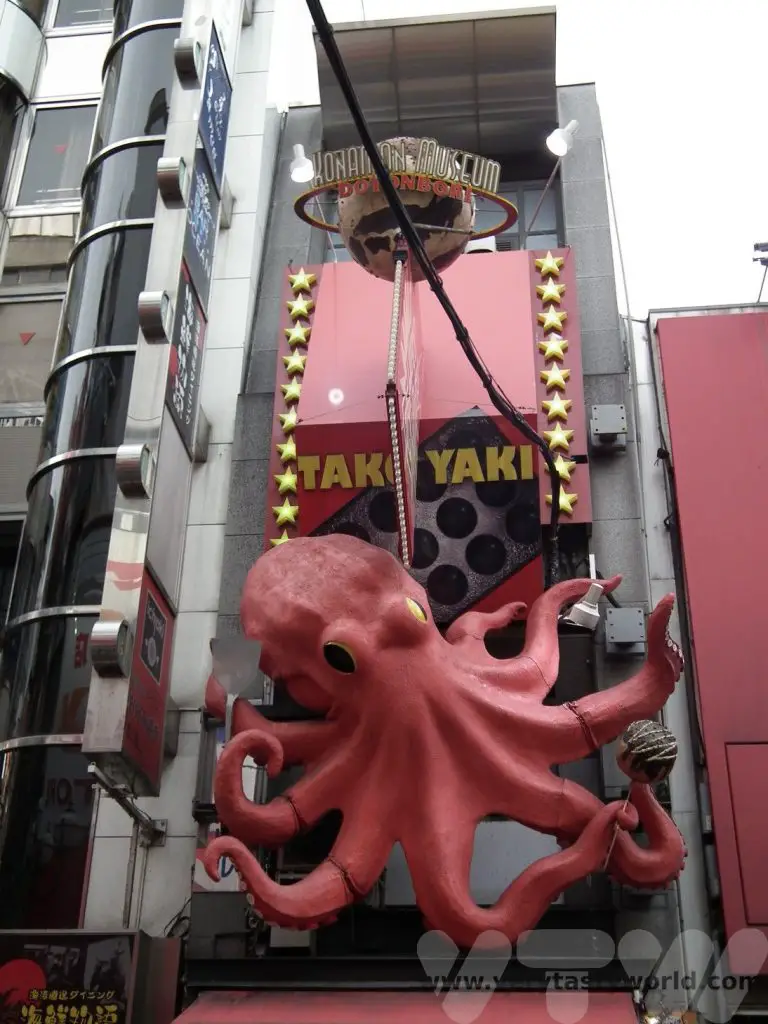
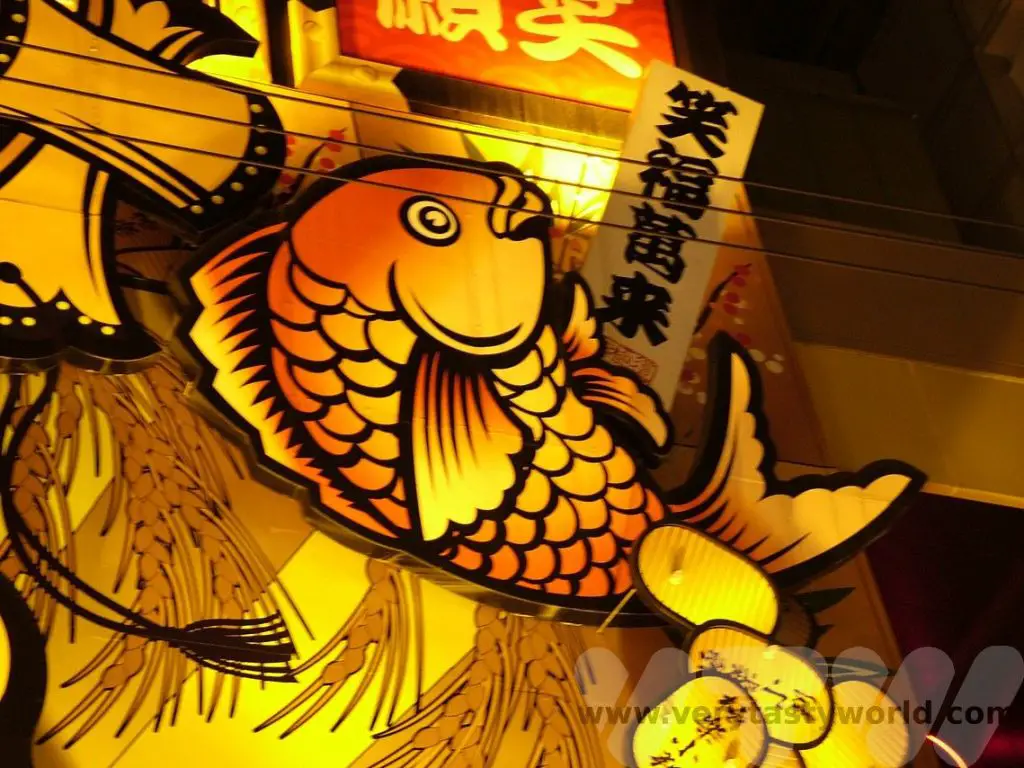
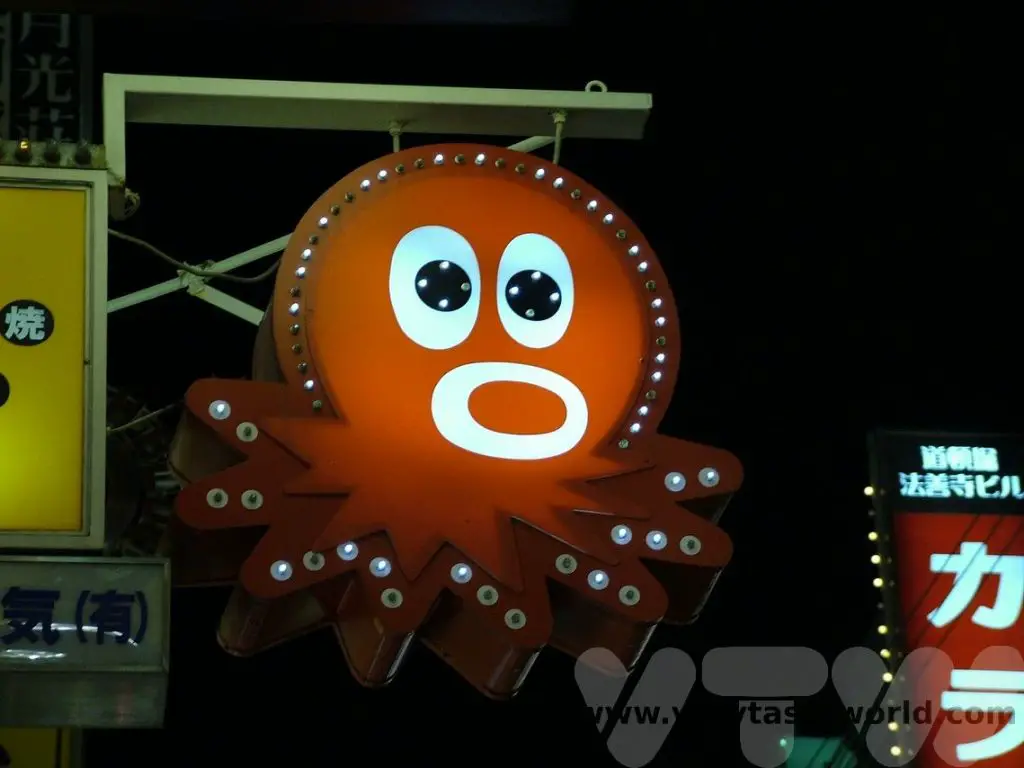
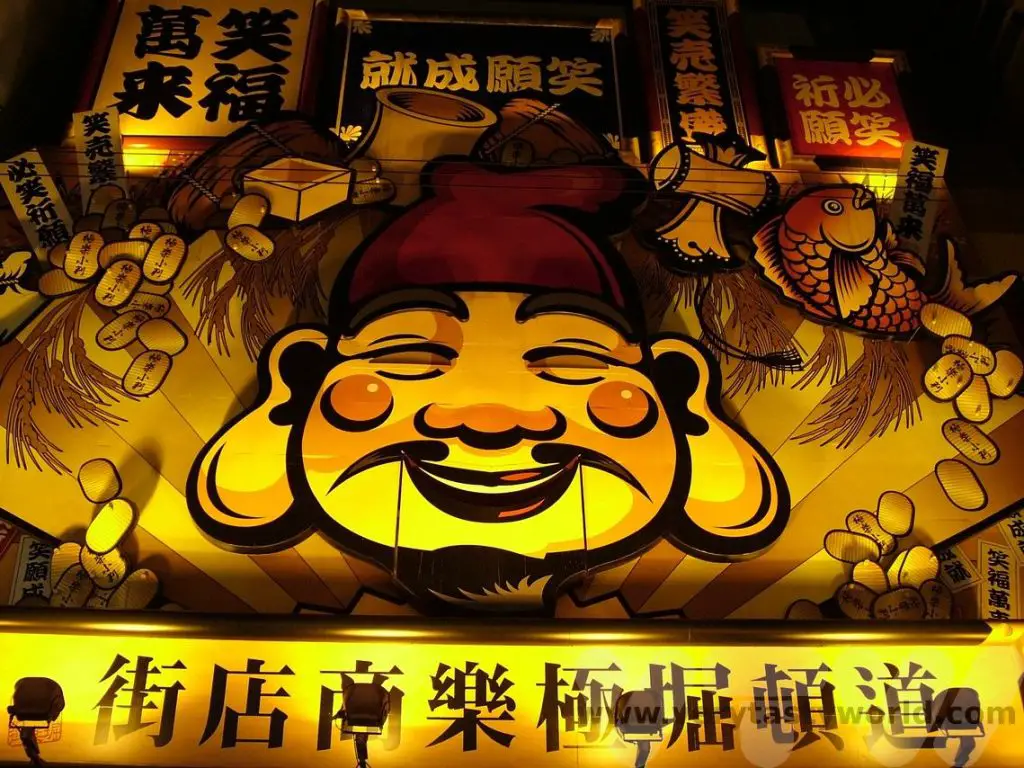
One thing to remember when visiting cities in Japan is to look up! In the UK most shops and restaurants are located at ground level but Japan is a country with high rise buildings. Very often shops and restaurants will be located on multiple levels within the same building. You will often see boards outside the building advertising various emporia: F1, F2 etc to go up, B1, B2 etc to go down. (N.B. floor levels in Japan match the American model where the ground floor is called the first floor, unlike in the UK where the ‘ground floor’ is at street level and the next floor up is the ‘first floor’.)
Essential Osaka Restaurants
Takoyaki – The Best Street Food
Takoyaki is quintessential Osaka street food. It comprises spherical octopus pieces in a batter which are cooked en masse in a griddle.
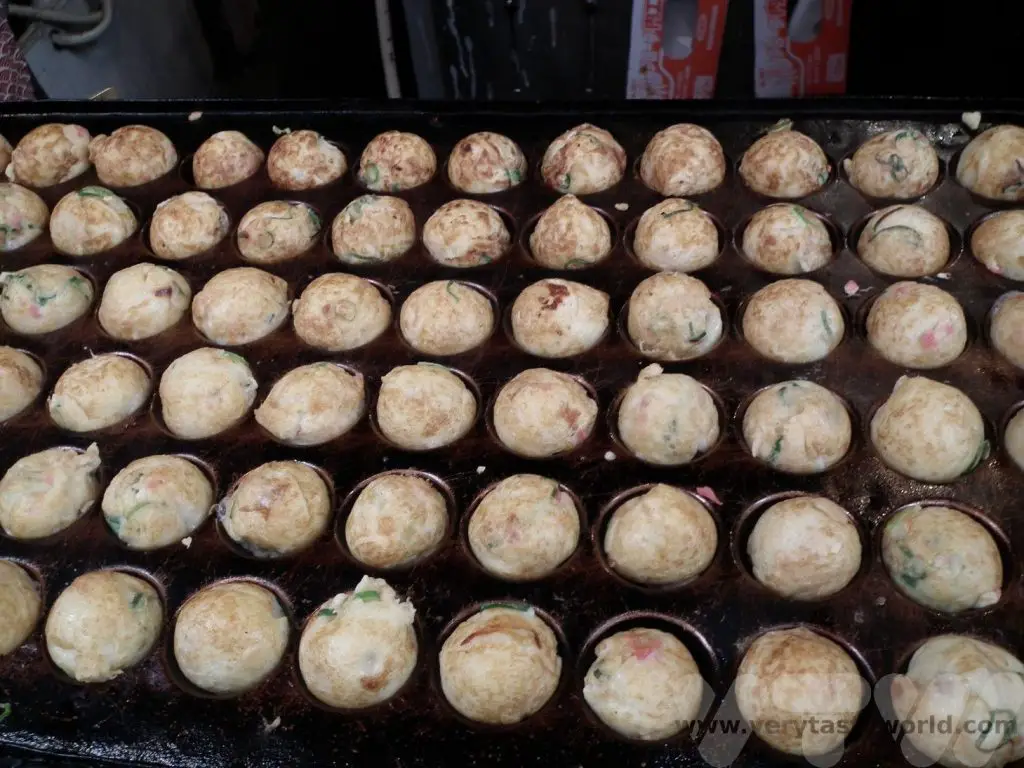
The takoyaki maker expertly and deftly turns each octopus ball by hand so that they are cooked evenly.
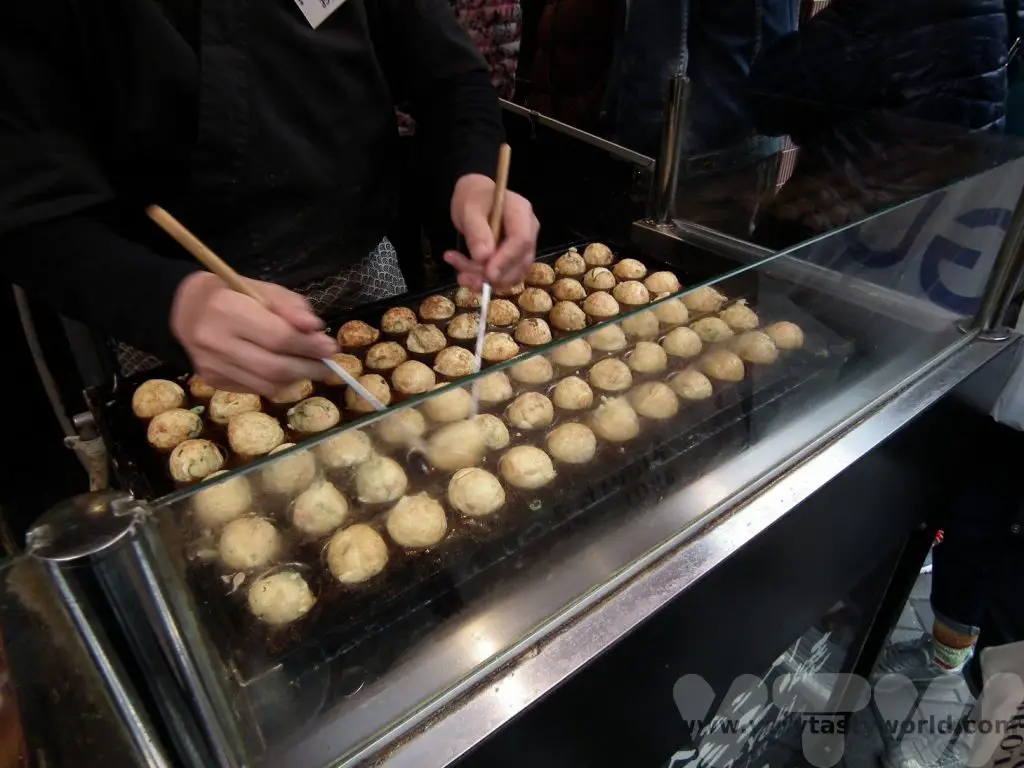
Served with mayonnaise, takoyaki sauce (which is similar to brown sauce) and bonito flakes (skipjack tuna flakes shaved to wafer thin slices – which are rich in umami and are often used to make Japanese dashi stock), which undulate gently in the heat of the takoyaki. You just have to wait a little while before scoffing because they will be extremely hot as soon as they come out of the griddle.
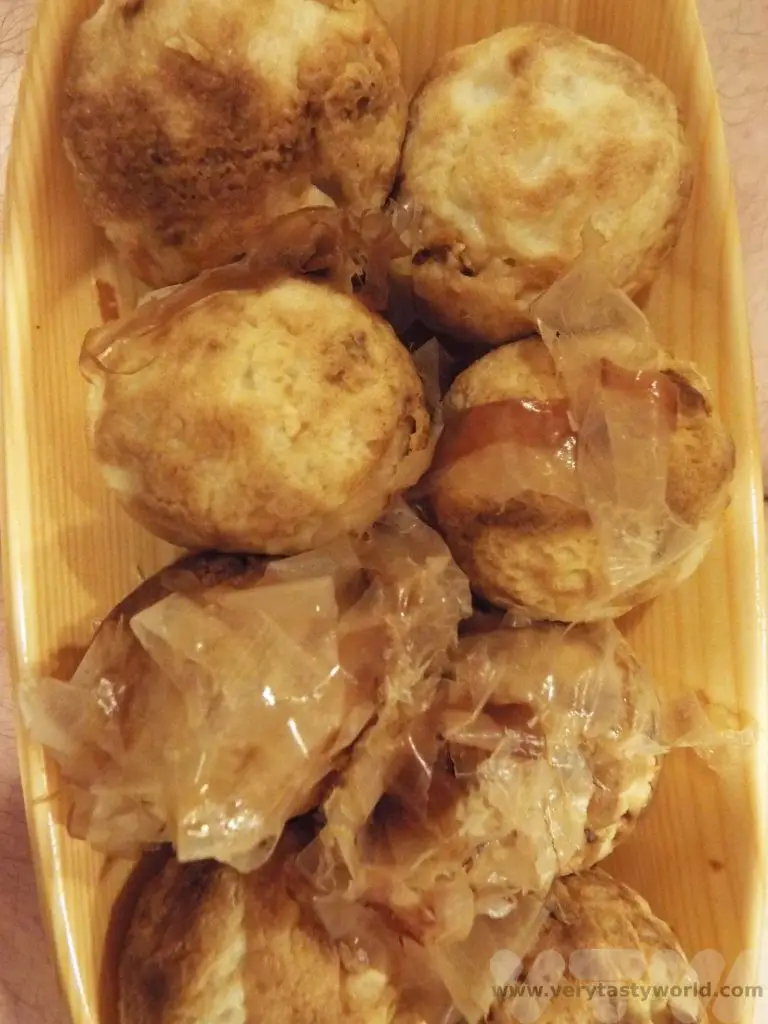
Okonomiyaki – As You Like It
Okonomiyaki, which translates as ‘as you like it’, is often described as a cross between a pancake and a pizza. It’s a cabbage based batter (but don’t let that put you off – it’s really delicious) with multiple fillings and toppings. Some establishments have a chef prepare the okonomiyaki, others will let you sit at the griddle and you can cook it yourself.
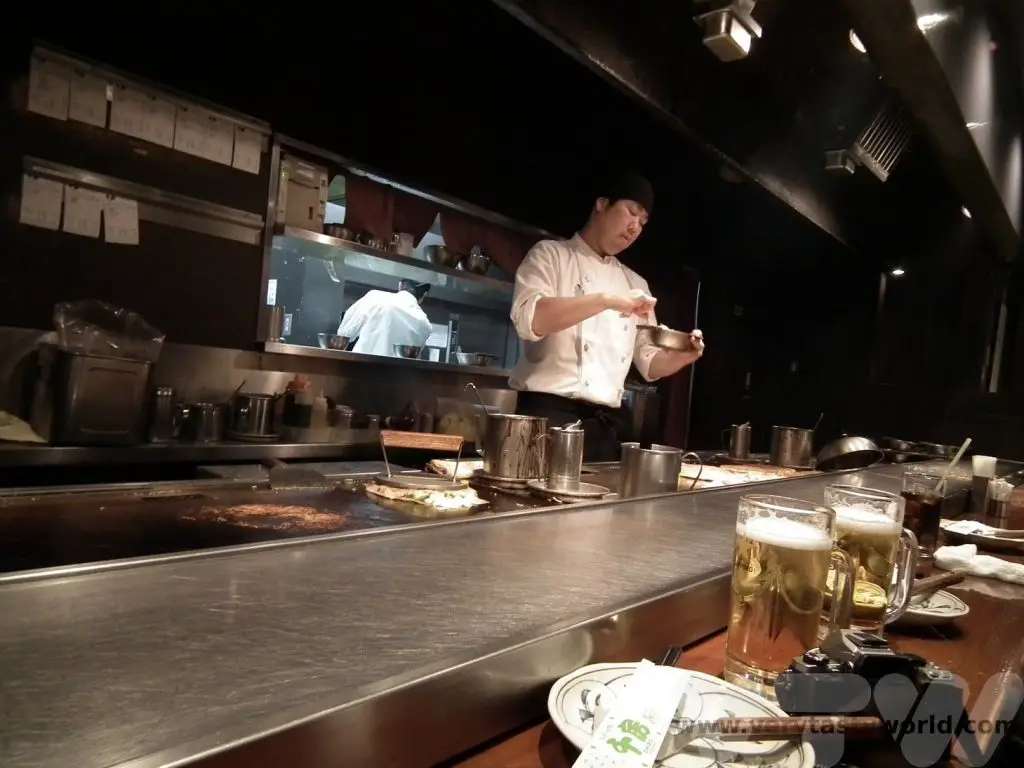
The basic batter mixture is prepared and cooked on the griddle.
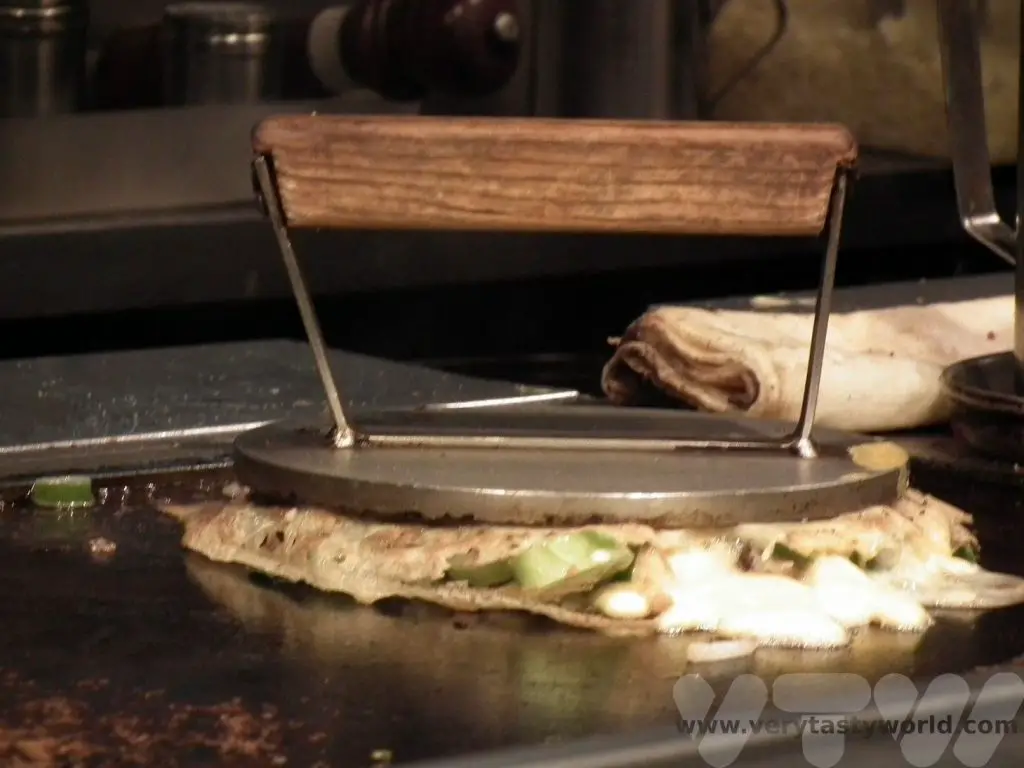
Then you have a choice of toppings – meat and prawns are popular choices and veggie options, such as kimchi are also available.
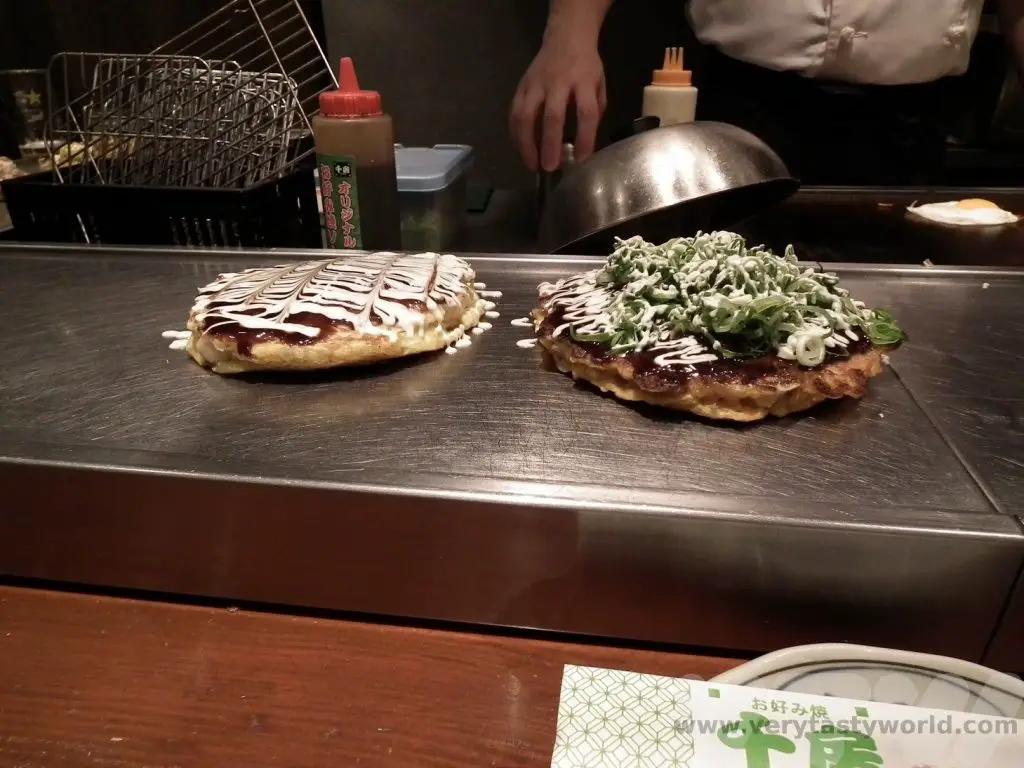
The okonomiyaki will be garnished with a variety of yummy things, including mayo, okonomiyaki sauce (similar to takoyaki sauce/brown sauce), flakes of nori seaweed and those delightful undulating bonito flakes. Chilli sauce may also be available. The chef will embellish your okonomiyaki in the most delightful way. And of course, when the chef asks you what garnish you would like, the correct answer is EVERYTHING!
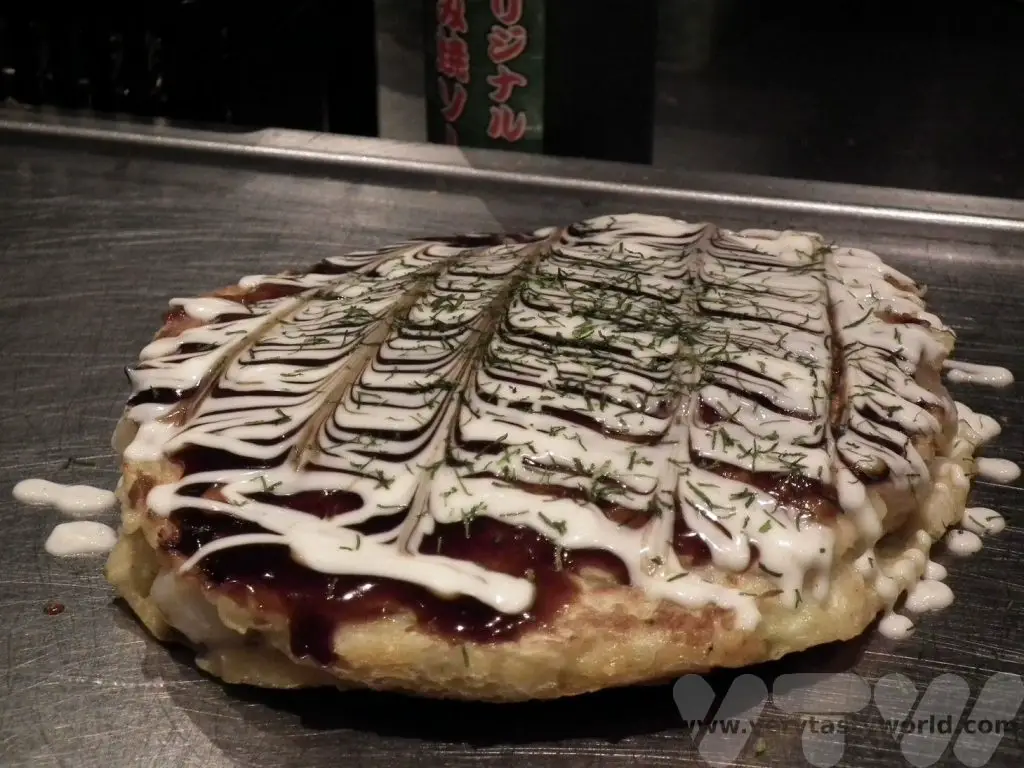
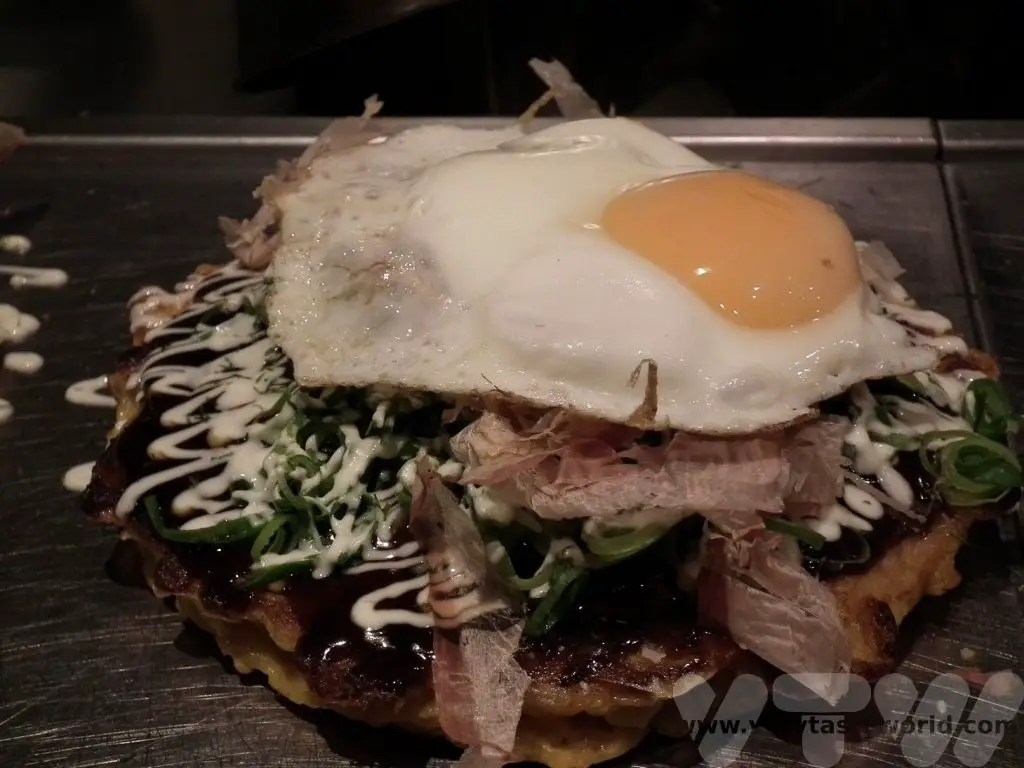
Fugu – Dare You Try Puffer Fish?
Fugu is the fish that has a formidable reputation – it’s the puffer fish, parts of which are deadly poison particularly the liver, the ovaries, eyes, and skin. The toxin basically paralyses you and you asphyxiate while still conscious. Not very nice at all.
But fugu is also a prized delicacy. The non-poisonous bits are fine to eat but absolutely can only be prepared by a licenced chef who has trained for several years. You can eat fugu all over Japan but it was at Zubora-ya, with its highly distinctive sign comprising a giant pufferfish lantern outside the restaurant, that we first tasted this fearsome fish.
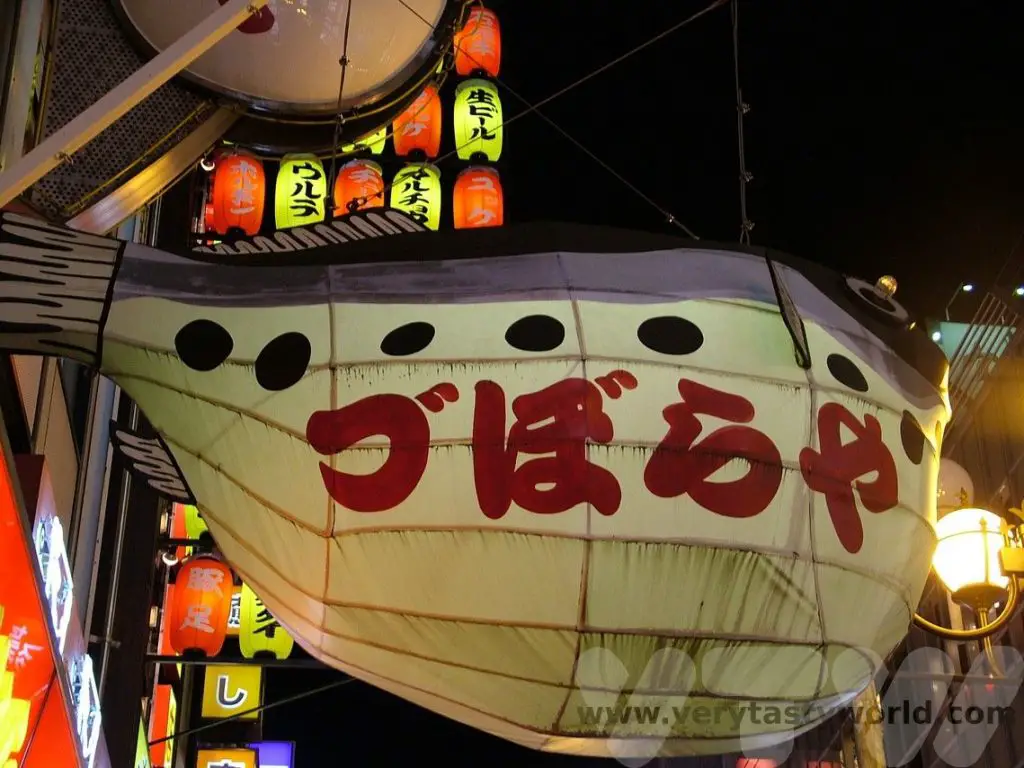
We thoroughly enjoyed a set menu at Zubora-ya – sushi and sashimi is the conventional way to enjoy fugu. It has a mild flavour and a firm texture that is something like a cross between squid and monkfish. It was delicious. And we survived!
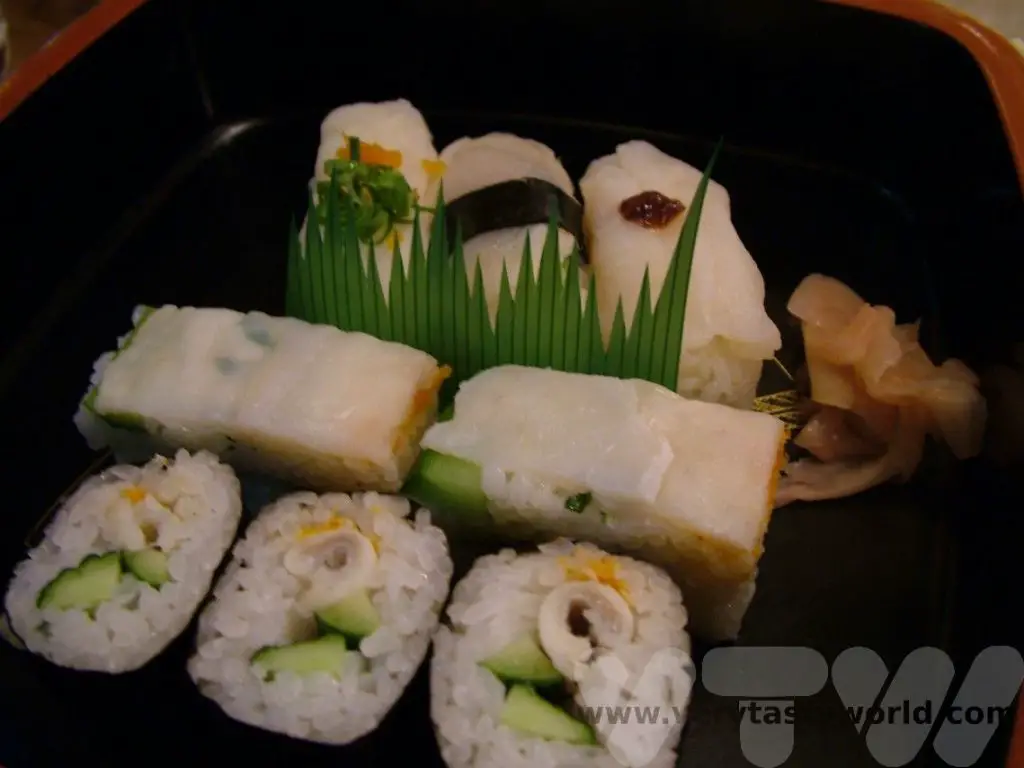
Sadly, Zubora-ya had to close during the pandemic and has not reopened.
Kani – Crab Heaven
Kani Doraku is another distinctive restaurant which has a model of a giant crab waving its pincers on the outside wall, beckoning you inside (well, that’s our interpretation!).

We have eaten here several times and always had a hugely enjoyable meal. Again, it’s a multi-storey building and, depending on how busy it is you may eat within the restaurant or be taken to a private room with tatami mat flooring and a telephone. The telephone was a bit daunting first time around but we picked up the phone and said, ‘kite kudasai,’ (please come here) and someone came along to take our order – which largely involved pointing at a picture menu. Even though it’s a large restaurant it’s very popular these days so it’s worth booking. There are actually multiple restaurants of this chain along Dotonbori, so check out the others if the first one you try is full. (The most popular is closest to the Glico Man.) The set menus aren’t cheap but they are good value and the food is utterly delicious.
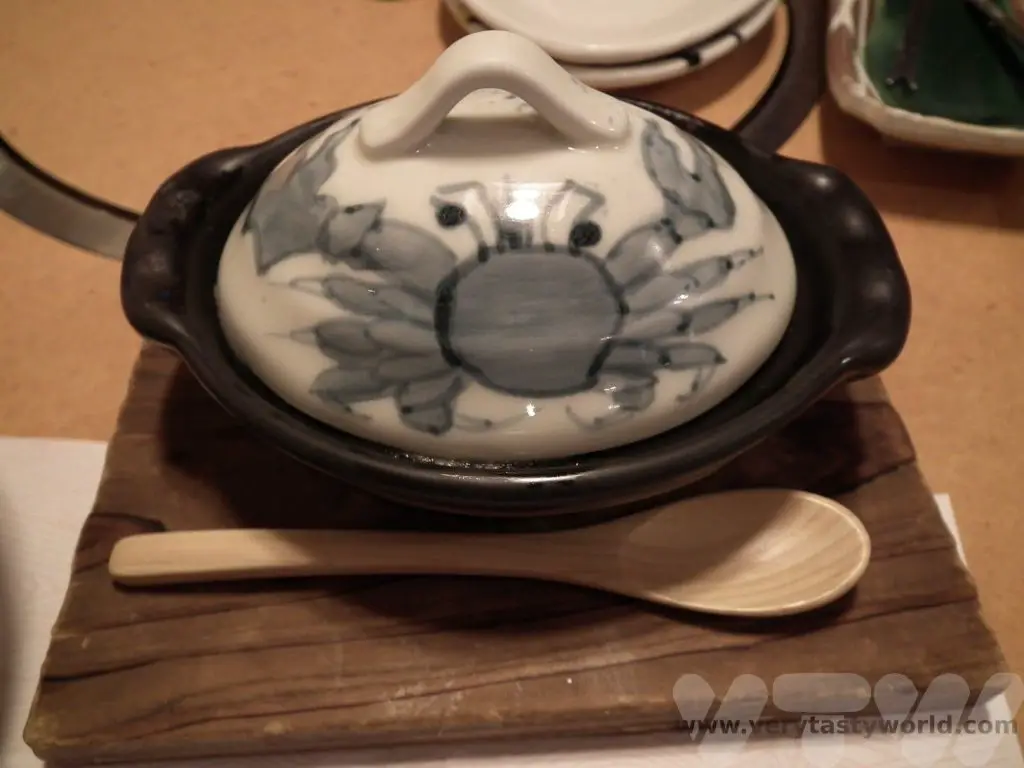
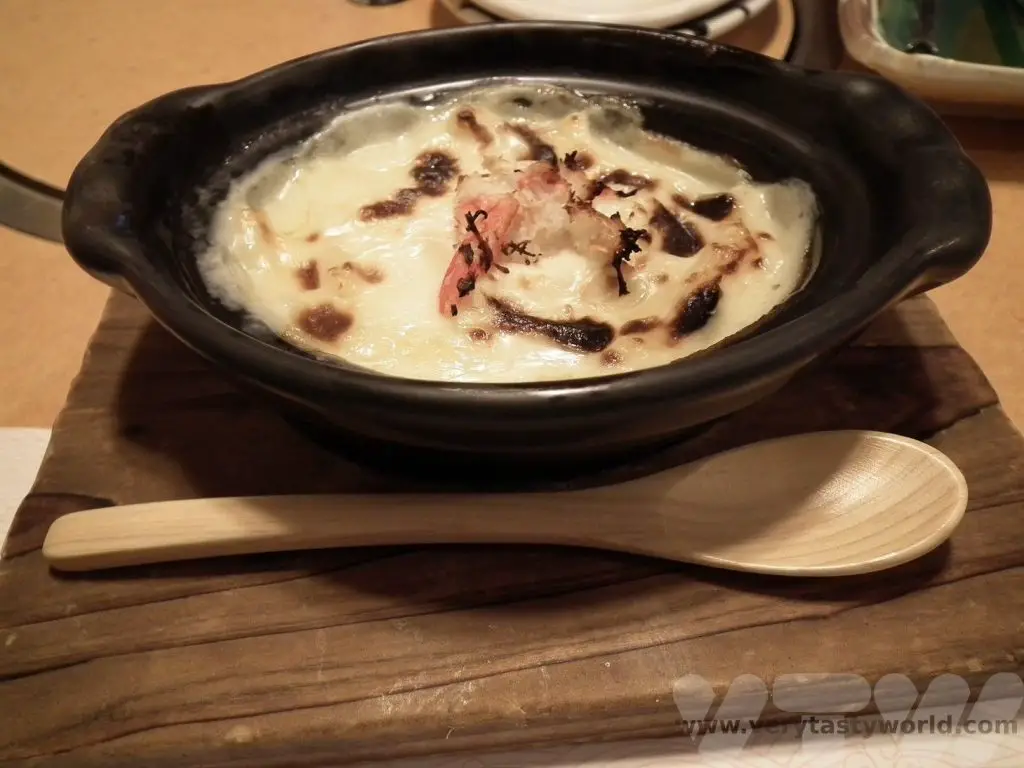
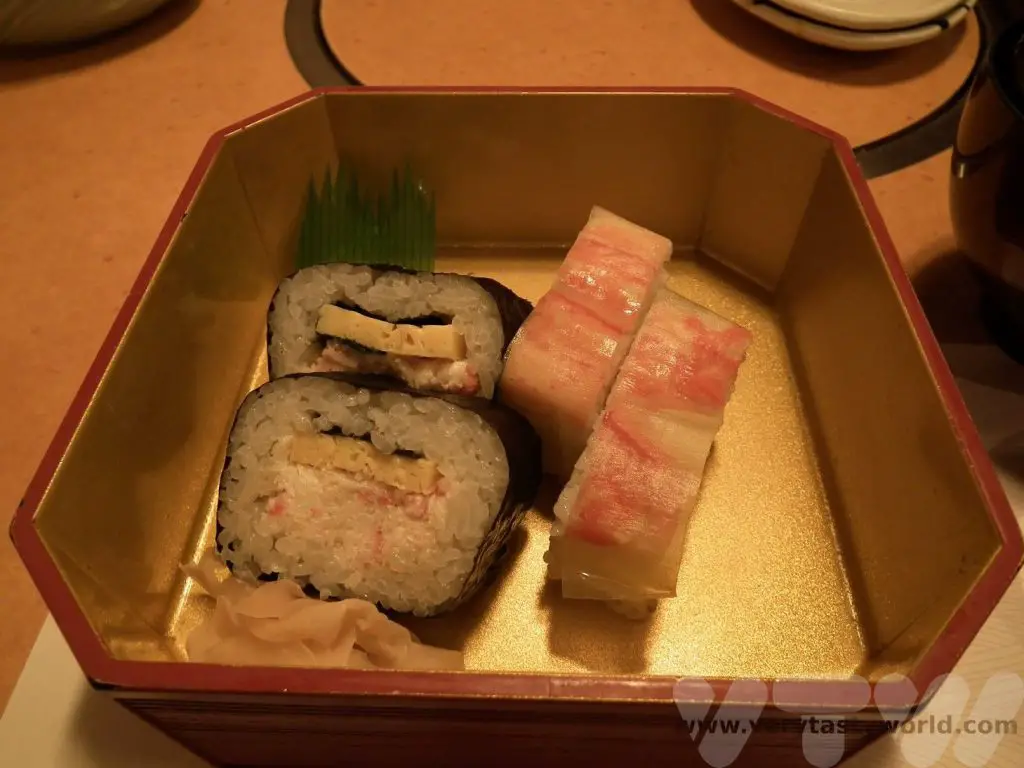
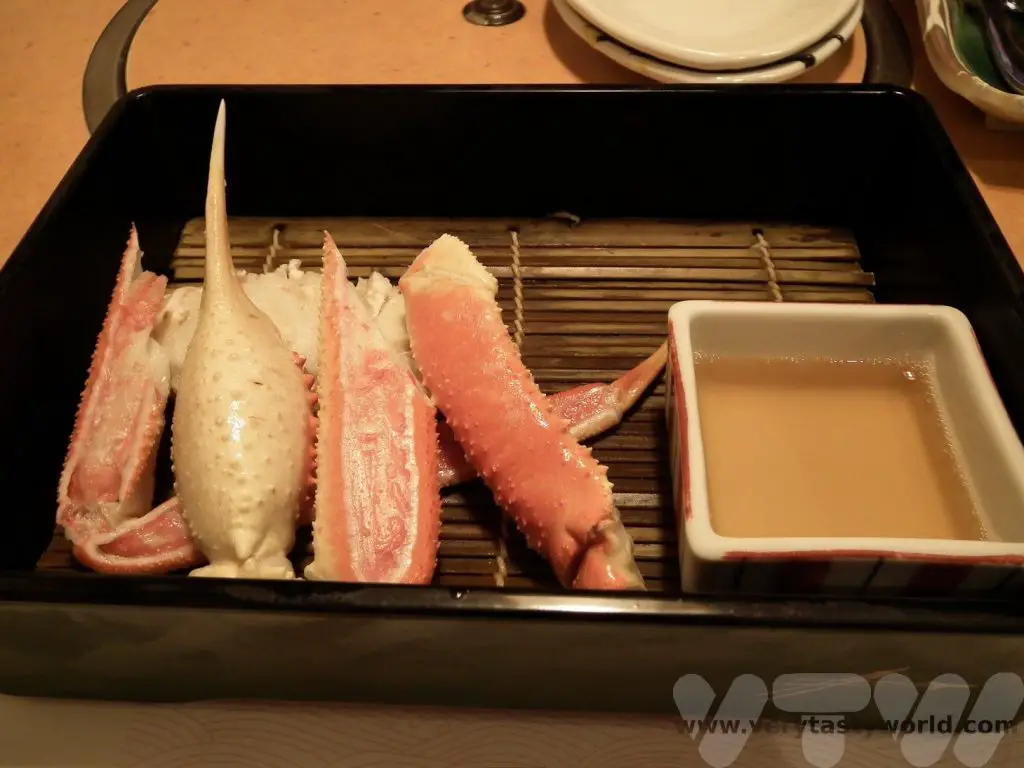
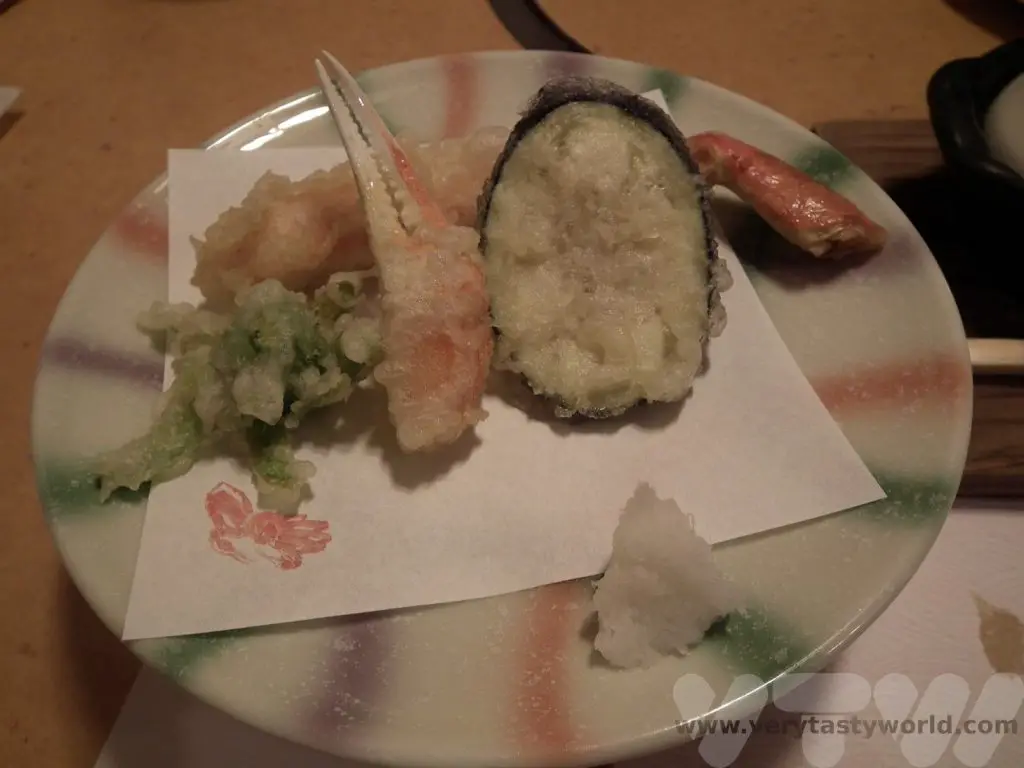
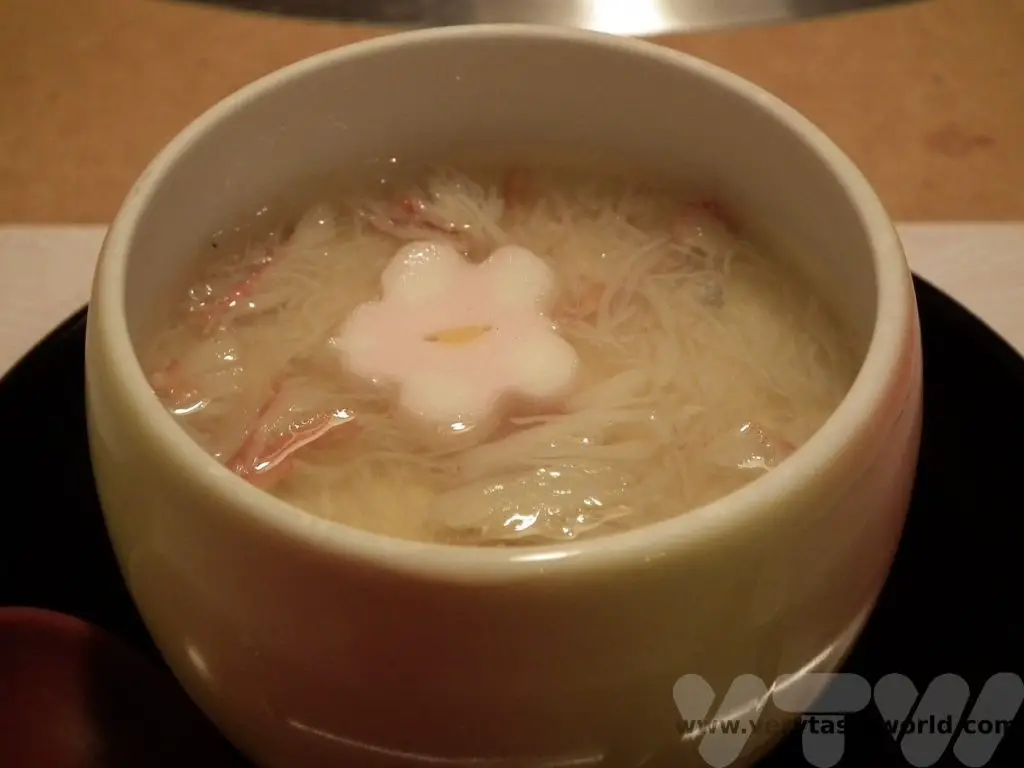
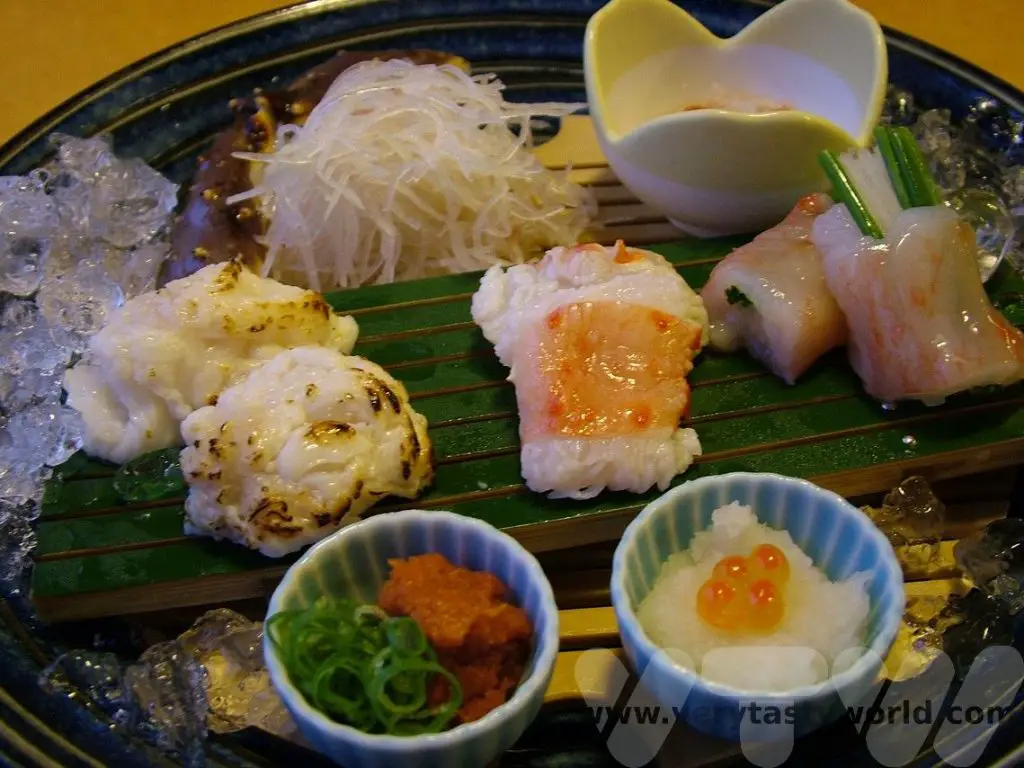
We’ve enjoyed crab sushi and sashimi, crab chawan mushi (steamed egg custard), crab tempura and crab gratin with a clear soup and matcha ice cream for dessert. Utterly delicious.
Other Dotonbori Establishments
There are loads of other restaurants along Dotonbori and the surrounding area. Kuidaore was an enormous eight storey restaurant founded in 1949. It was recognisable by its iconic Kuidaore Taro Clown, a vaguely creepy mechanical drumming puppet at the entrance. Sadly it closed some years ago but the building was populated by different shops and restaurants in what’s now known as the Nakaza Cui-daore Building.
If you like ramen noodles (and who doesn’t?) there are three Kinryu restaurants along the street. Kinryu translates as ‘golden dragon’ and the restaurants can easily be found by their distinctive dragons on the hoardings above the shopfront.
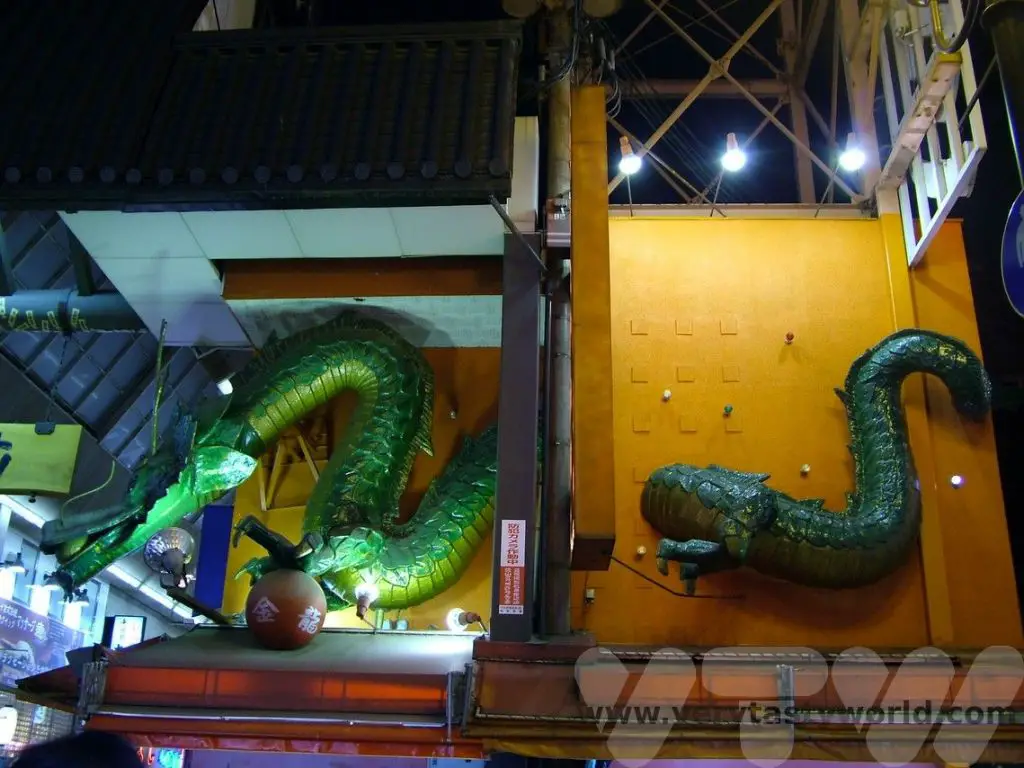
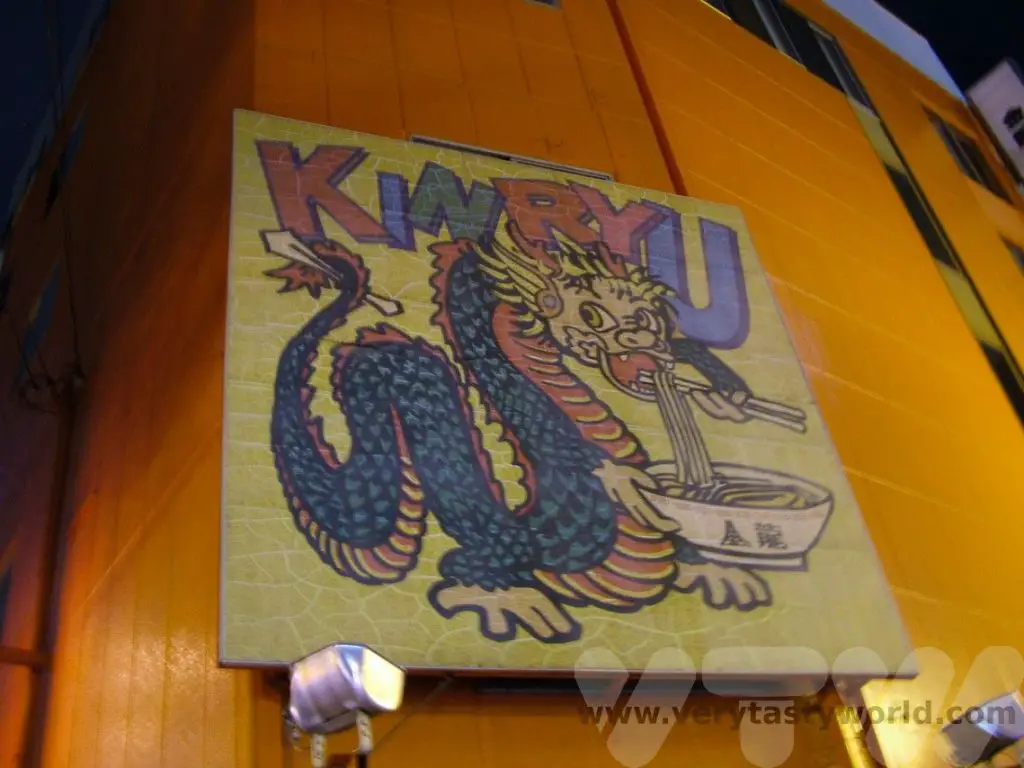
And even the standard restaurants on Dotonbori, those without the amazing neon signs, are worth checking out. One of the great things about dining in Osaka – and indeed throughout Japan – is that you don’t need to speak or read Japanese. Many restaurants will have an English, Chinese or Korean menu and those that don’t will often have a picture menu or, better, realistic models of the food in the window, usually with prices. You can take a photo of your desired dish or even take your food server outside and point to the dish you want.
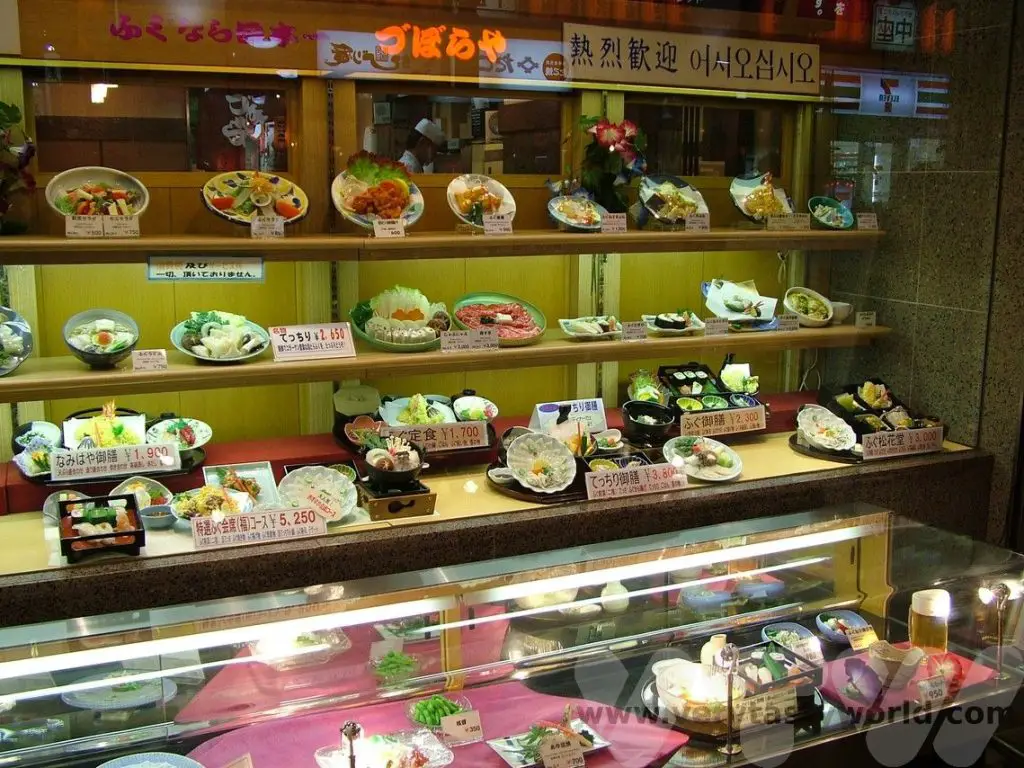
The models of the food are surprisingly realistic and many are made in Osaka. We managed to find a shop that sold them but they are hideously expensive, so we treated ourselves to a couple of sushi fridge magnets as a souvenir.
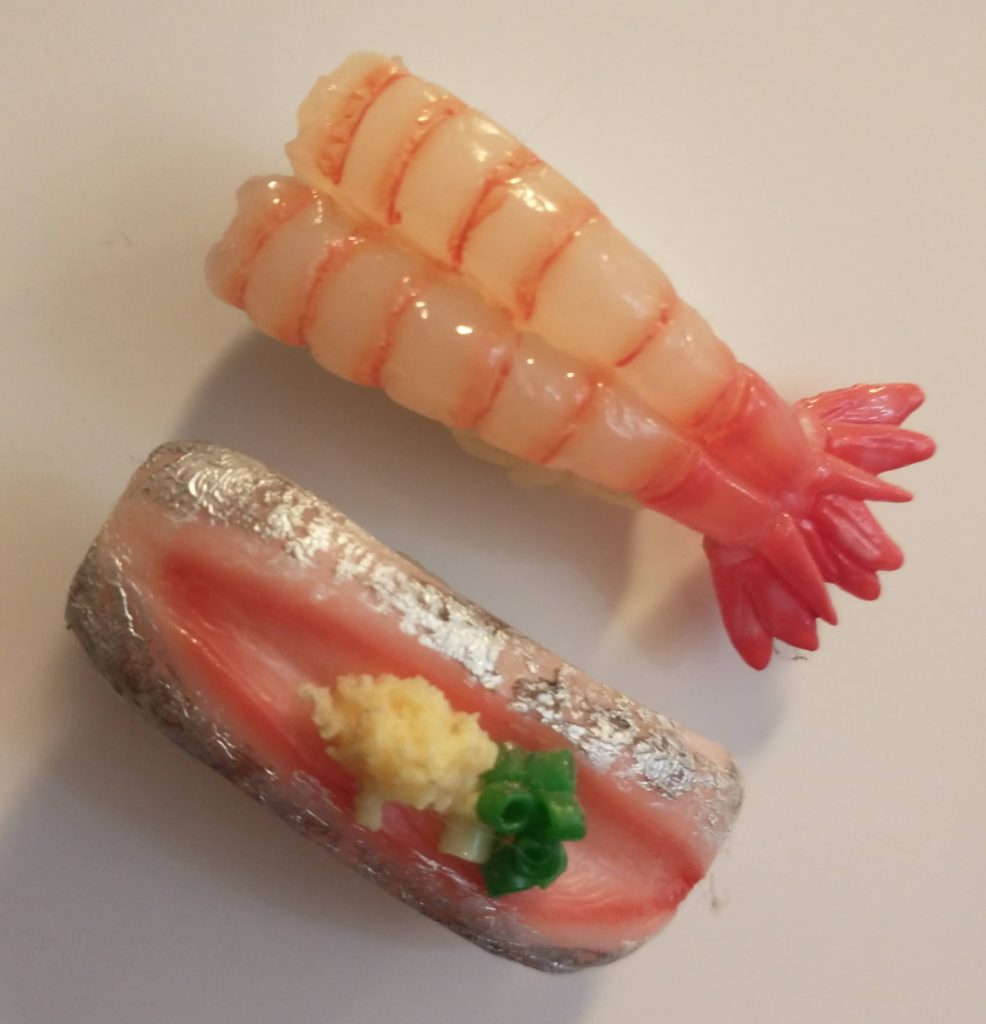
Related Posts You May Enjoy

- Kobe Beef in Kobe – Is It Worth It?

- World’s Best Breakfasts -Breakfast of Champions!
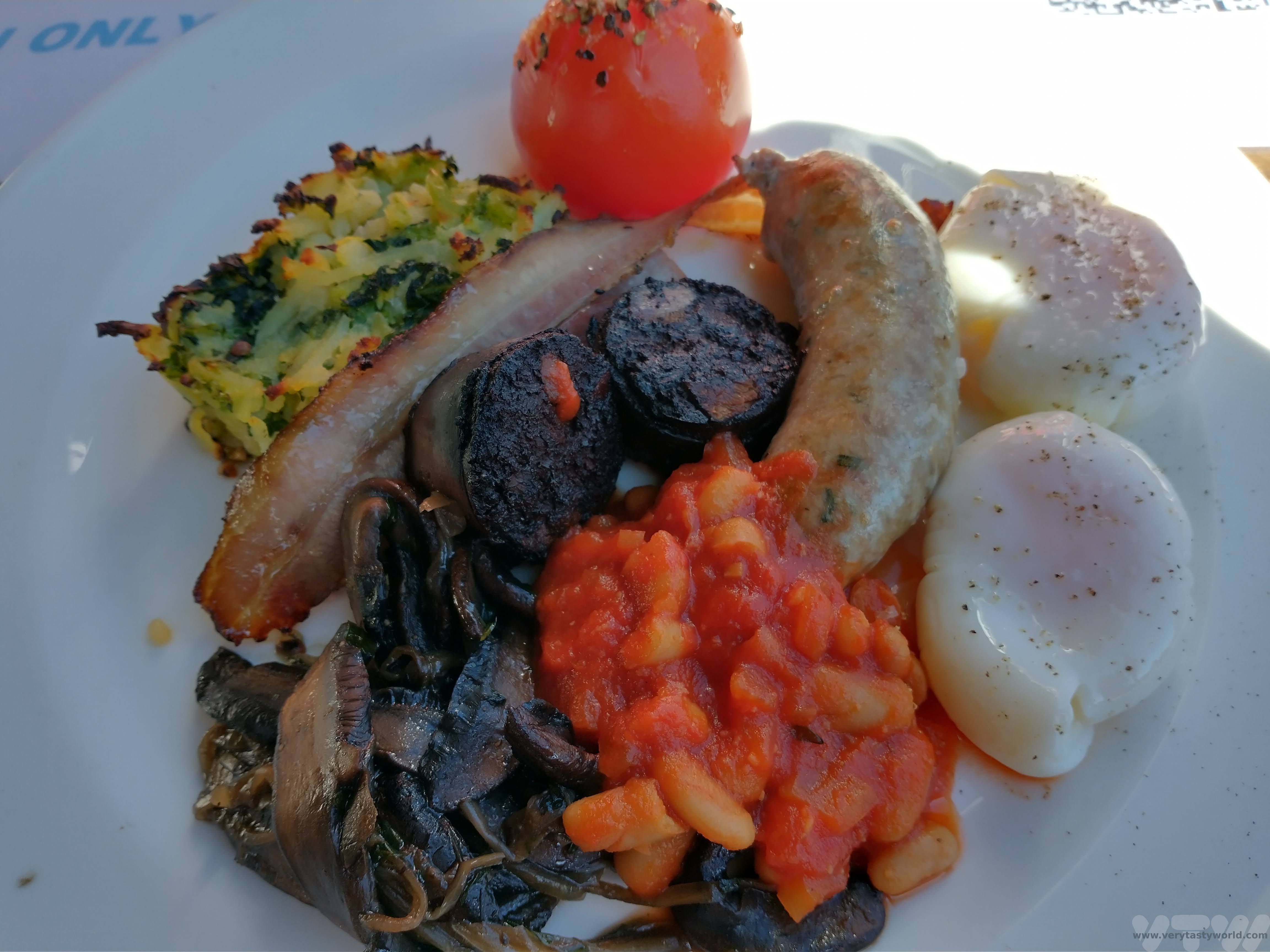
- Recipe: Simmered Shiitake Mushrooms
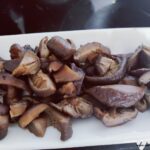
- How to Use Public Transport in Japan
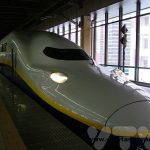
- RECIPE Oyakodon Donburi
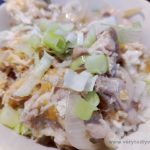
- Planning a Trip to Japan
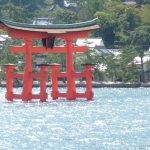
- The Makanai: Cooking for the Maiko House
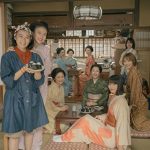
- Setsubun Food – Bean Throwing Day
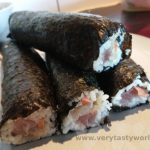
- The Gassho Farmhouses of Rural Japan
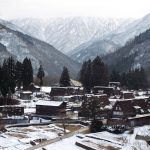
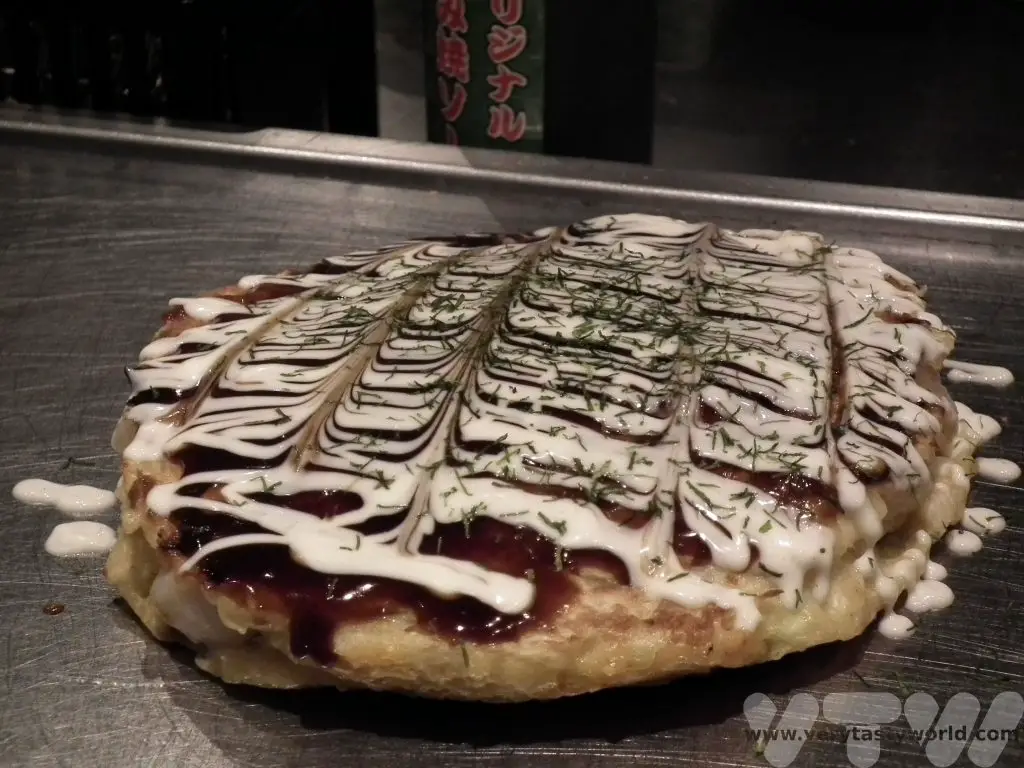
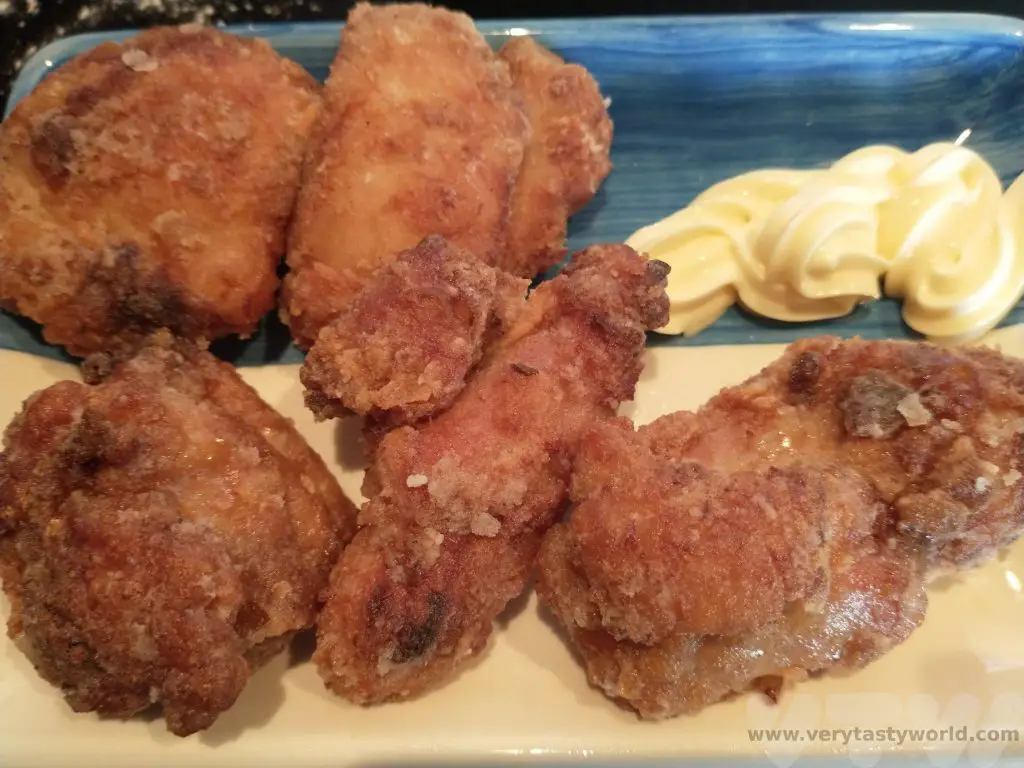
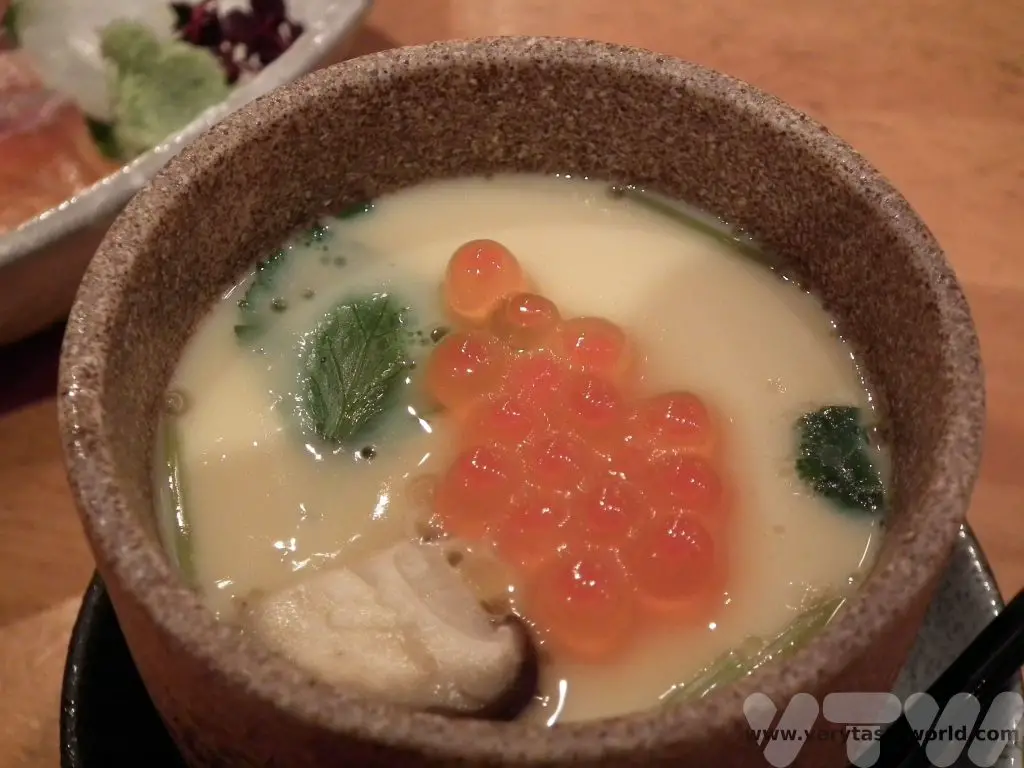
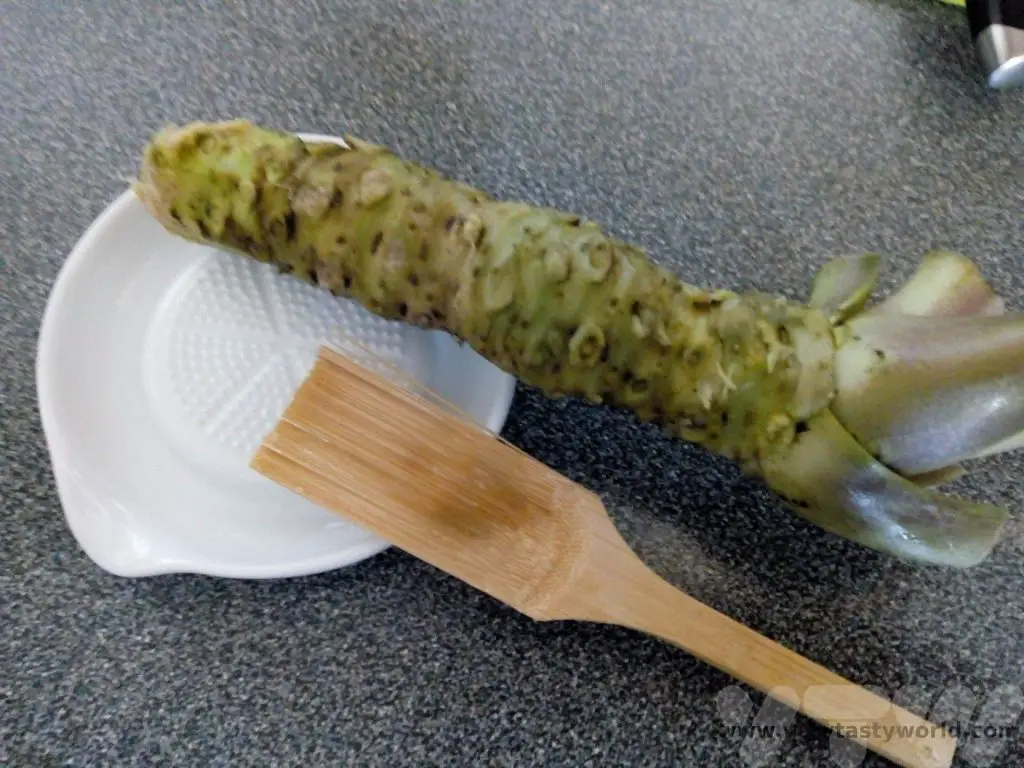
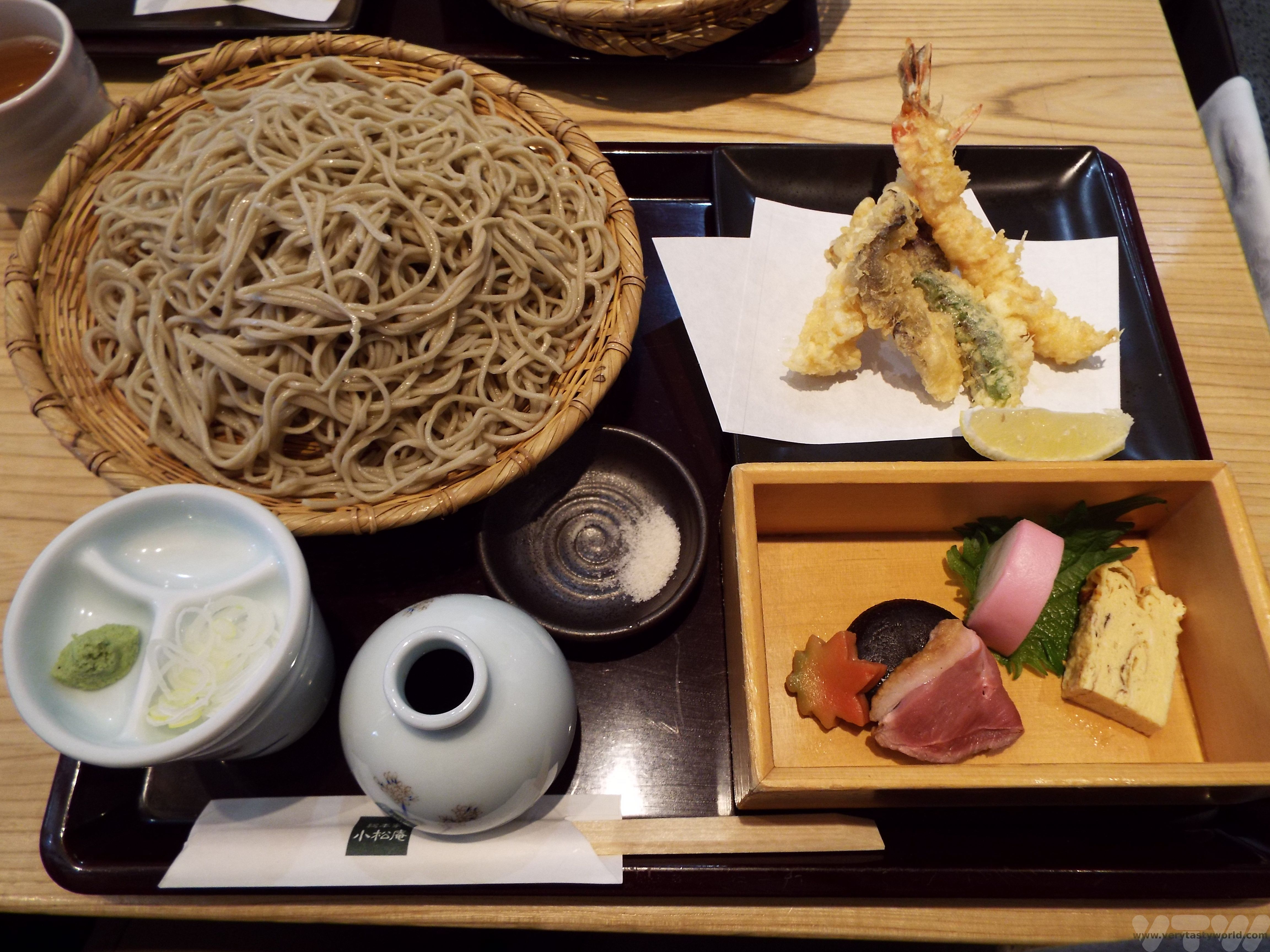
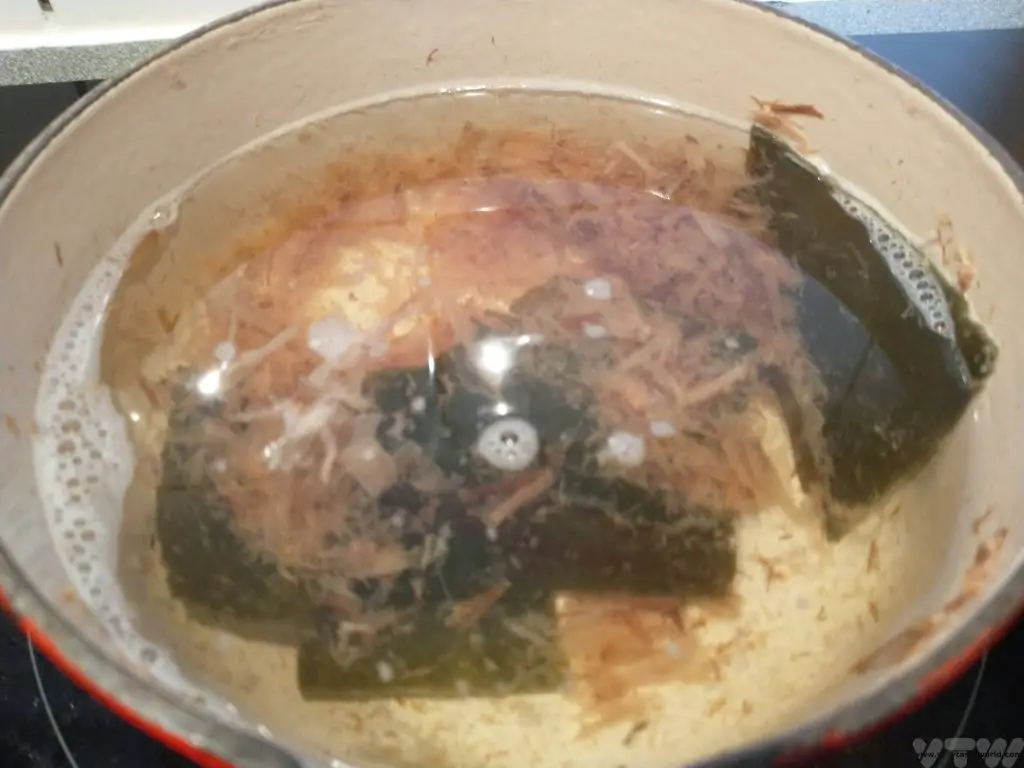
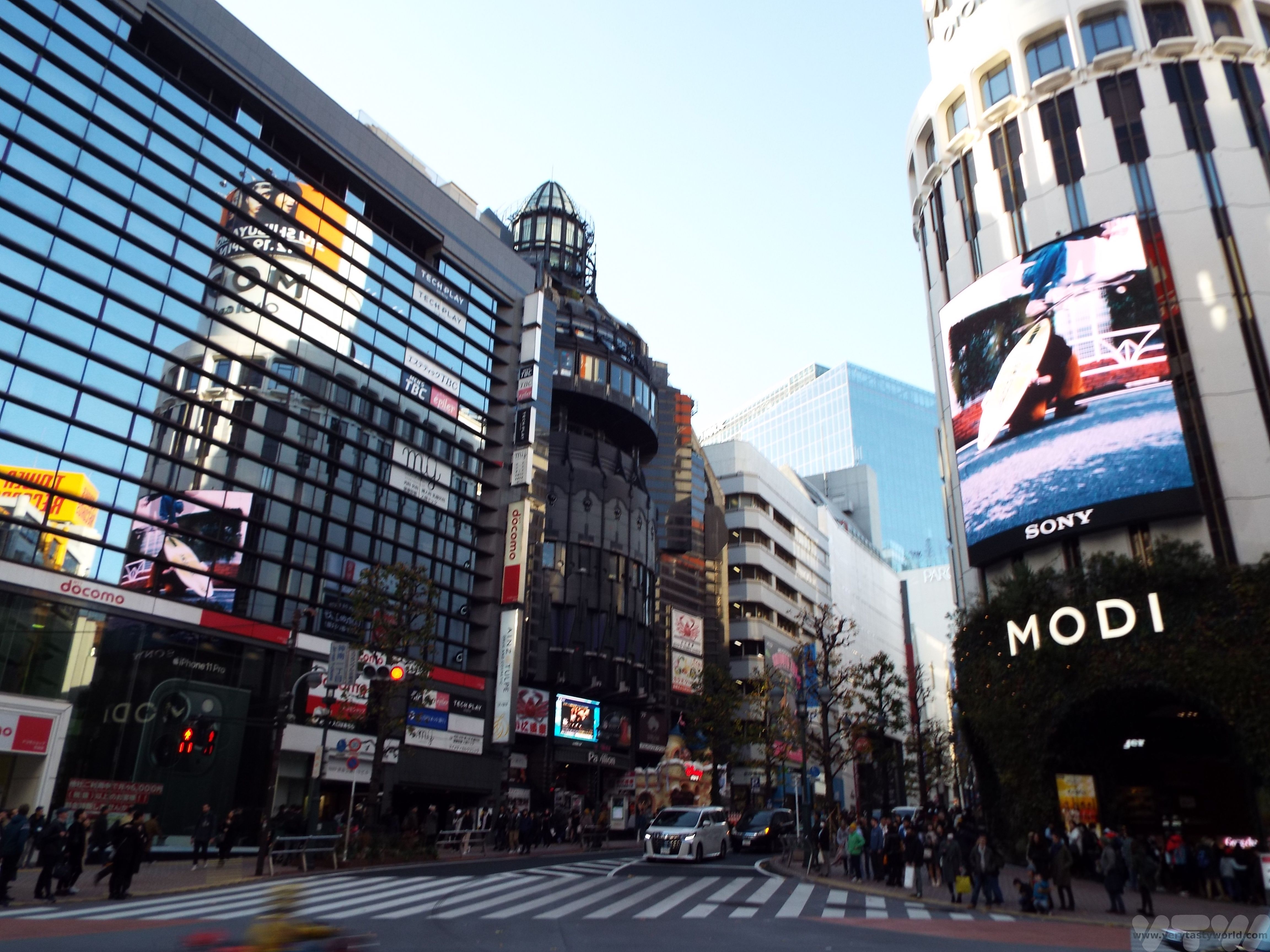
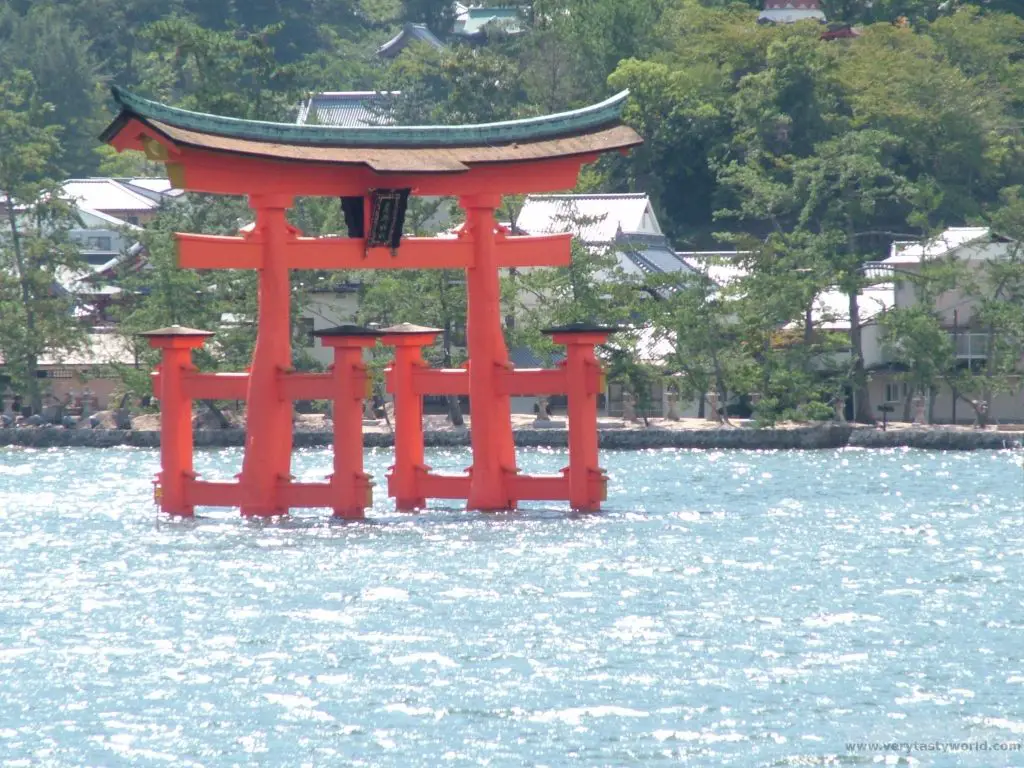



Always wanted to try fugu but agree if I do it will be at a very well established restaurant. The food looked amazing. Great post as always.
Thank you! Fugu can’t be served unless the chef is fully licenced. We went to a well-known restaurant, although sadly it has now closed following the pandemic. There are other fugu options available in Osaka and across Japan. We really enjoyed tasting it.
I am convinced the German language needs a translation for ‘kuidaore’ just to describe my every day behavior. Every dish looks delicious. I am a fan of the huge octopus on the picture by the way^^
Hee! We are the same! I think we might just have to adopt ‘kuidaore’. All the dishes were absolutely delish. And the octopus signs are great. In fact, we managed to bring home a cuddly octopus as a souvenir from Osaka!
Your love for Japan really rubs off, Mitch. I was already a huge fan of the archipelago, but with every one of your Japan posts, I get more enthralled.
The neon and 3D plastic signs all look so cool, but it’s the food that gets me. I had heard of puffer fish (kudos to you, and glad to hear you lived to tell the story) and tried okonomiyaki, but takoyaki is something new.
It’s nice to read that you enjoyed arcade video games and karaoke, I always presumed Ellie and I are the only Westerners who get sucked into that part of Japanese culture.
Thank you so much for your kind words, Stefan. Yes, Osaka is a really cool place to visit and you’re right, the food is just amazing in Japan. The puffer fish was surprisingly good, and we were really pleased to have tried it. We’re delighted to know that you enjoyed the arcades and karaoke when you visited Japan – we love them! We always keep our 100 yen coins just in case we come across an arcade (which is usually a strong possibility!) and we can have a bash at a random video game.
This post made me extremely hungry! The food looks so delicious, a nd I love all the neon signs. Nice to know that even if I didn’t know the language I could still get something to eat. 🙂
Thank you! Yes, the food was awesome. I don’t think we’ve had a bad (or even an average) meal in Japan. The food models in restaurants are such a good idea – you instantly know what to expect and they also show the prices as well.
I love all those signs they use, neon or otherwise. I’d want to stop everywhere just to take a look around. I also find it great fun they have a word dedicated to people who go bankrupt from spending money on food. Sometimes I feel like that describes Michelle and me!
We’re totally with you on the kuidaore, we do love our food! The signs in Japan are brilliant, it’s a pleasure just to wander through the streets taking in the sights. (And then gof or a wonderful meal!!)
Anything Japanese – I’m all in! Food, booze, a good belty karaoke, maybe dress up a little (Japanese style), anime and all that kawaii’s 😉
Takoyaki had been my go-to-meal back in my college days and I’am starting to miss the comfort it lends to the spirit.
Delighted to hear that! Oh yes, takoyaki is a fantastic comfort food; you can get takoyaki grills over here, we might have to look into getting one.
Japan is such a great foodie destination. This post made me hungry! Great read as always.
Thank you so much! Yes, the food in Japan is one of the many, many reasons we love it there.
Your passion for Japan really comes through in your articles and like you I learned to love this country. Great to finally know that Dotonburi means Doton’s (surname) canals – it puts it into perspective and I never realised they were so old. I have to admit I saw it briefly in the daytime from afar and said I would go back in the eve, but sadly never did. I really should make more time for food on my trips. I tend to get back to the hotel, shower and flop from exhaustion from the days sightseeing – that’s why I always try to get a hotel with an on-site restaurant for convenience.
I adore sushi and have to admit that I often bought it as takeaway to take back to the hotel in japan – scrummy. the crab menu restaurant would be a go to for me but I think I may give the Fugu as miss – stuff like that scares me ! If we ever coincide in Osaka I’m defo calling you to enlighten my palate around these fabulous restaurants and show me the gastronomic delights of the city that I sadly did not get round to seeing.
Thank you so much for your kind comment. I can understand the flop-factor after a hard day’s sightseeing. We, too, pick up takeaway sushi from konbini (convenience stores) and often have them for breakfast if we are staying in a business hotel. They are delish! We would be delighted to show you around Osaka if our travels coincide. The crab restaurant would be an absolute winner!
The food and surrounding area has completely drawn me in!! We have to hang out with you guys sometime!! What a great piece, plus I finally can put a name to my affliction, haha!!
Thank you so much! Yes, kuidaore is such a brilliant word! And we’re always up for a night on the town!
We’re big fans of Japanese cuisine and those are some of our favorites (maybe leave the puffer fish for the next customer)
Japanese cuisine is one of the world’s finest – we absolutely adore it. We were a bit apprehensive about trying puffer fish but went to an established restaurant with a very good reputation. We’re glad we tried it – and very much enjoyed it!
[…] good if you are a salaryman who has had a late night out in the city. Or tourists who have had a late night in the city which involved chatting with all sorts of very interesting people in random bars and drinking quite […]
[…] to their style. This crab chawan mushi savoury egg custard, from the famous crab restaurant on Dotonbori, Osaka was very simple in terms of its ingredients, the flavour was delicate and […]
I would love to eat my way around Japan. Everything in this post looks delicious. I have a lovely Japanese friend who is currently living in Tokyo, I think I need to pay her a visit soon.
I like your fridge magnets, I like to collect fridge magnets from places we visit, but I think my collection is getting a bit too big.
Oooh, we definitely recommend getting in touch with your friend in Tokyo. We are totally in love with Japan and the cuisine is just one of the things that make it so amazing. We like collecting fridge magnets too!
Oh my goodness, that was a delicious post worth savouring slowly and carefully. I do love Japanese food from sushi to noodles. I now know what I’m ordering for dinner although it won’t be in Osaka.
heh, I have too many fridge magnets. I display mine on thin sheet metal in shadow frame boxes on my walls because I actually hate clutter on the fridge!
Lyn | http://www.ramblynjazz.com